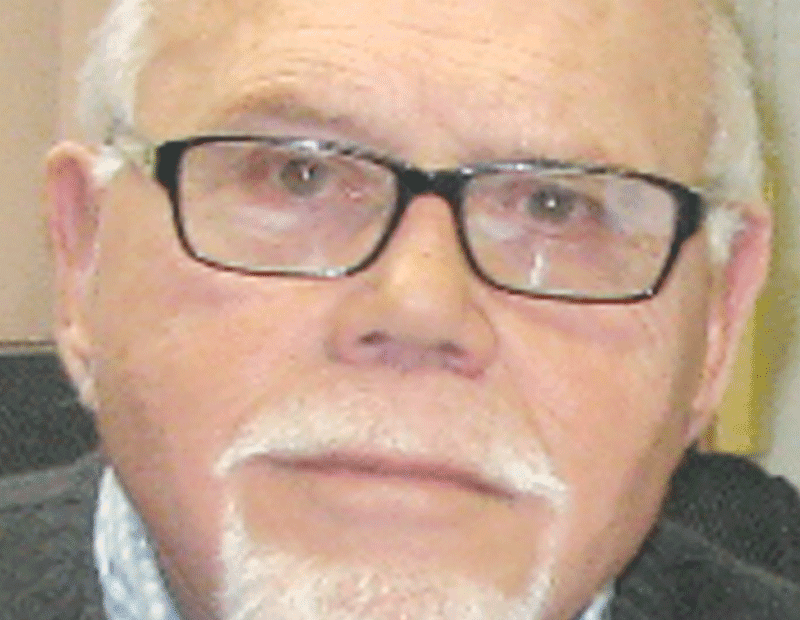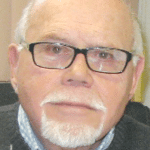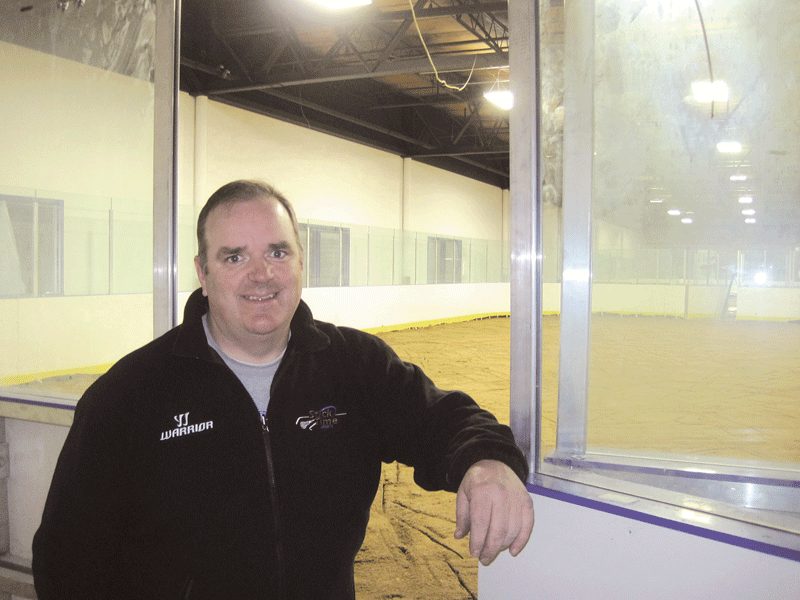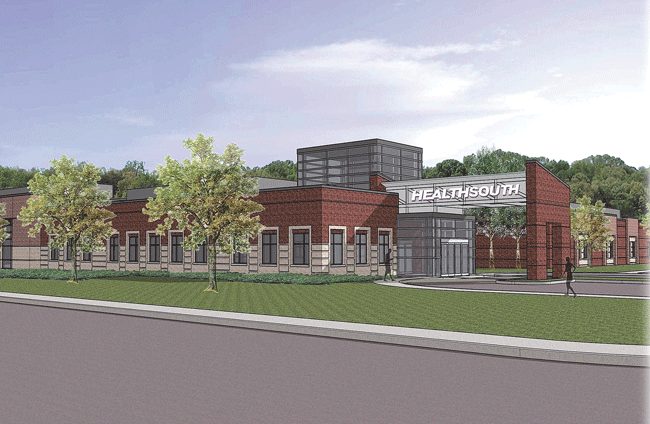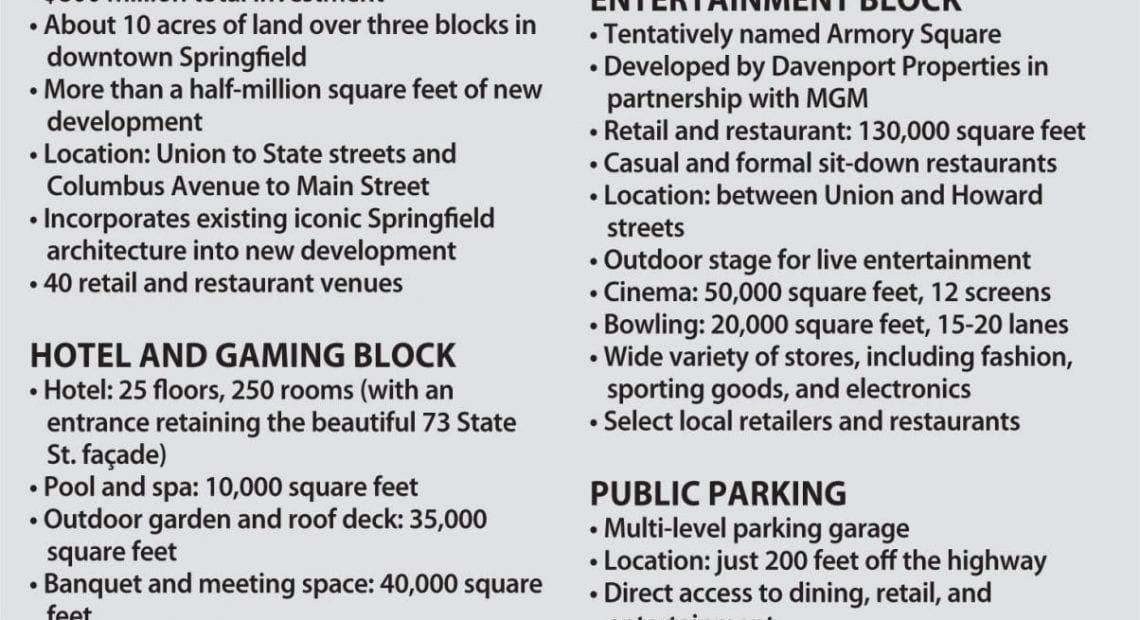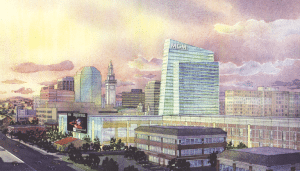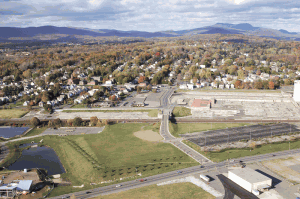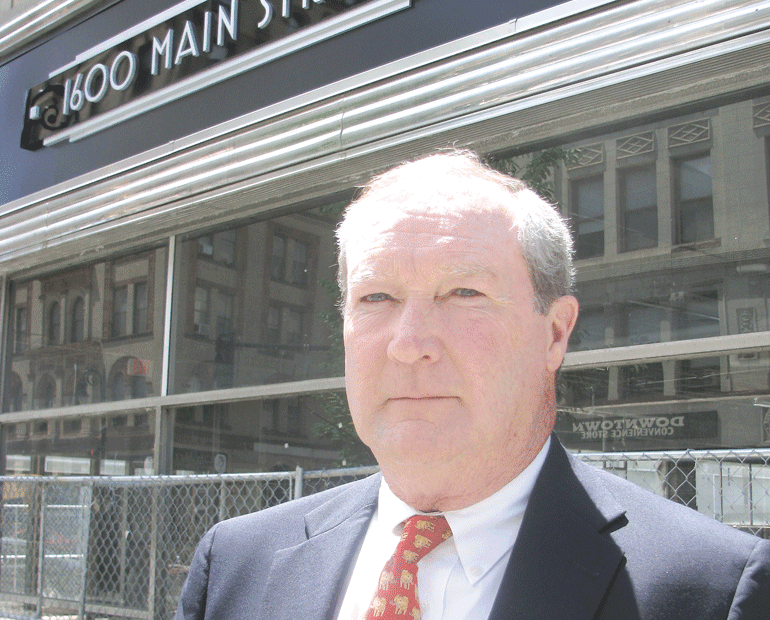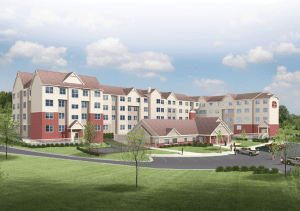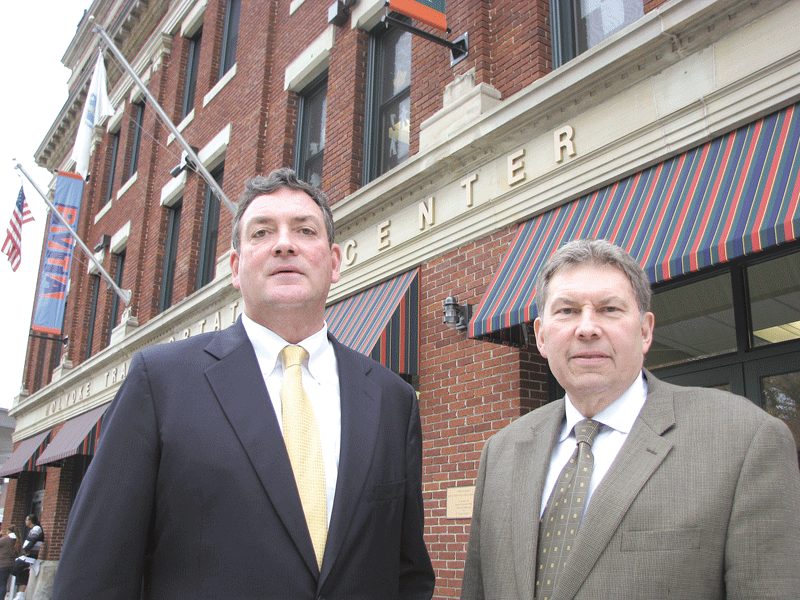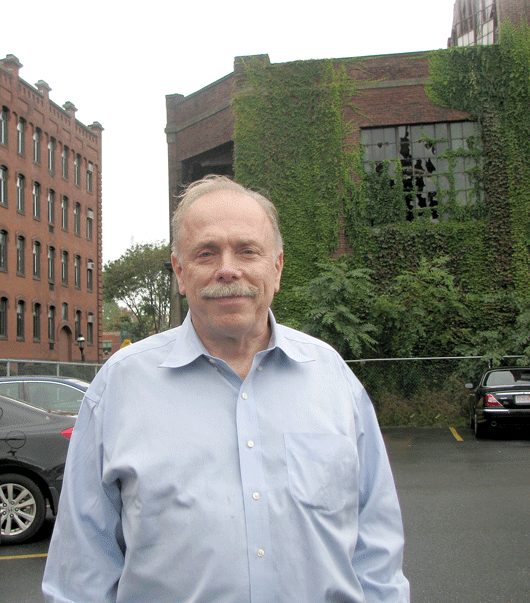Commercial Real Estate
Northampton Commercial Real Estate Market Remains Resilient

Patrick Goggins, owner of Goggins Real Estate, says the resiliency of the Northampton commercial real estate market is no accident — it results from the city’s welcoming atmosphere.
“It’s so far and away from other markets, there really is no comparison,” said the president of Williamson Commercial Properties LLC in Springfield.
Steve Jasinski agrees. “The Northampton area seems to have been isolated from the downturn in the economy, it didn’t suffer the same pitfalls that occurred in other areas,” said the broker at Delap Real Estate LLC in Northampton and Amherst, explaining that the city’s economic and social diversity, strong employment base, and unique character of its downtown have provided a formula for success that is reflected in the value of commercial property.
But Patrick Goggins, owner of Goggins Real Estate in Florence, who has been in this business for more than 40 years, says the steadiness of the market is no accident. Instead, it results from a collective commitment on the part of business owners who have devoted time, energy, and thought to creating an atmosphere that is personal and welcoming to visitors.
He told BusinessWest the reason for Northampton’s success is fairly simple. “People are doing their own thing, but many businesses on Main Street are run and managed by owners who are here day in and day out. It adds a personal touch, which brings with it personal attention and gives them a better chance of succeeding and understanding the community and its needs. They know that connecting the dots is important, so they are a very active group, and when they see something is needed, they pitch in.”
Officials at Smith College have also joined forces with business owners to keep downtown vibrant, and have played a significant role in its financial success. “The town and gown works well here,” Goggins said, adding that the college has supported the Chamber of Commerce, Business Improvement District, Academy of Music, the new fire station under construction, and other organizations that play a role in the city’s unfalteringly robust economic climate.

Brokers John Williamson, left, and Steve Jasinski say downtown Northampton offers people a place to shop and dine in an intimate, personal setting.
“People leave here and talk about the diversity of Northampton — we’re known throughout the country and you can go to different parts of the world and mention the city and people recognize the name,” he noted. “But people have been key to its success and keep the economy going.”
Downtown and King Street are home to most of the commercial real estate, and two new banks, three car dealerships and other businesses recently opened their doors or are under construction on King Street. “It’s our commercial strip,” Jasinski explained. “And it isn’t just growing, it’s booming.”
Williamson agrees, and points to new developments such as Northampton Crossing, (the former Hill and Dale Mall), which sat vacant for about 20 years, but was purchased two years ago and is being re-developed into medical offices and retail shops. “King Street plays an important role in the balance of the Northampton commercial market,” he said.
Signs of vitality can also be seen at the gateway to the city, which officials designate as the area off Exit 18 from I-91 near the Clarion Hotel. A new 30,000-square-foot office building was completed there about a year ago.
“It was fully leased three months later,” said Williamson, adding that a second, similarly sized building is under construction. “There is not another office market anywhere in Western Mass that has this amount of positive absorption.”
New Frontiers
Goggins said that when he was a student at UMass Amherst, the businesses in downtown Northampton existed to serve the needs of the local community.
“In the late 60s, there were five men’s clothing shops and five hardware stores downtown,” he recalled, adding that the marketplace catered to men.
Fast forward to the early ’70s, when Fitzwilly’s restaurant opened and proved that it was possible to have a business that could cater to both college students and their parents.
“It was a new marketing concept for the area,” Goggins said, noting that it was the catalyst that changed the complexion of the downtown landscape. “But the interesting part is that it was not something that was promoted or orchestrated. There was no magic plan; it just evolved naturally through entrepreneurship. But it took people with nerve to open businesses here.”
In time, it became fashionable to have an office downtown, which led to a demand for housing there, Goggins recalled.
Jasinski said the large number of residences in and around Main Street contribute to the economy and strength of the city. “One of the key components to the success of downtown is that it is a neighborhood,” he told BusinessWest.
However, Goggins said the character of the buildings has remained the same for generations. He noted that in the mid ’70s the city council voted 5-4 against urban renewal at a time when other communities were embracing it and knocking down buildings in blighted areas.
“It was a very, very important vote and presented the base from where we have grown,” Goggins said. So, although apartments and condominiums were carved out of underutilized space on the upper floors of buildings, “they never changed architecturally, although they have been enhanced.”
He cites education as the primary economic driver in the city and said it has been a steadying force.
Jasinski concurs, and adds healthcare to the conversation. “We have great employers here, and jobs create a strong economy,” he said, as he talked about the five colleges and Cooley Dickinson Hospital. “And anyone who comes to Northampton seems to fall in love with the city due to our diversity, uniqueness, and the warmth of the community. You can walk down Main Street to Smith College and go through the gardens and greenhouse and around Paradise Pond. There is a lot to do and people are key to the success of the economy as they keep it going.”
It is also significant that rents have not risen significantly. “I am renting some spaces for the same price per square foot that they went for 10 years ago,” Goggins said.
But that doesn’t mean they are low. Downtown rents range from $25 to $40 per square foot, with locations closest to Thornes Market on Main Street capturing the high end of the market.
“The average is about $25 per square foot, which is comparable to what you would find in much larger cities,” Goggins said. “There isn’t even a close comparison anywhere else in the area.”
Changing Landscape
King Street is experiencing rapid commercial growth due to zoning changes instituted two years ago. “It was the only area where there was available land, but it was not conducive to commercial development so in the past people couldn’t take advantage of it,” Goggins said.
The change resulted from efforts on the part of the City Planning Department, the chamber, a group of residents, and a number of individuals, including Goggins, to position that area for growth.
Since that time, auto dealerships and other businesses have sprung up and continue to grow. “There are really only two parcels left that are right for development,” Goggins said. “The growth there has been a real eye opener for people.”
Williamson said King Street plays an important role in the balance of Northampton’s commercial market and allows institutions such as banks to have drive-up windows, something that’s not possible downtown. “There are two new auto dealerships under construction and Baystate Medical Center plans to have a medical clinic at Northampton Crossing. Most of the space there has already been pre-leased,” he said.
Another development that has been well received is the River Valley Co-op at the extreme north end of King Street. “It does a really bustling business,” Williamson said.
Goggins told BusinessWest that the city Planning Department is also interested in developing the corridor off Exit 18 on I-91. Cooley Dickinson Hospital is one of the primary tenants in the new office building there, and he expects the site that is under construction to be dominated by medical offices.
Meanwhile, property on Village Hill, built on the grounds of the former Northampton State Hospital, has also been in demand. L-3 KEO (formerly Kollmorgen) relocated there from King Street, a boutique hotel is being created in a building that once housed male attendants at the state hospital, and 9,000 square feet in a new 12,000-square-foot office building under construction are already under lease.
Goggins played a role in the revitalization, and said 150 of the 300 housing units planned for the site are complete and there are plans for several more buildings, which will contain a combination of office, industrial, and retail space.
The site is only three quarters of a mile from downtown, and although most tenants and building owners have been downtown for a long time, real estate opportunities do exist. The building on Main Street that housed the Mountain Goat is for sale, and a building across the street was recently sold to an individual who plans to renovate it.
“There is a lot of demand for property to lease as well as buy,” Jasinski said, adding that businesses often open on side streets, then add a second location on Main Street or eventually move there.
But real estate doesn’t come cheap. “A high end multi-tenant building in downtown Springfield that was fully occupied recently sold for $41.25 per square foot, where a similar building in Northampton would cost in excess of $200 per square foot,” Williamson said. “That really illustrates the difference between the Northampton market and other central area district markets. But the amount of availability is just about perfect, and there is just the right amount of churn. There is not so much vacancy that it is a deterrent to the market, but there is enough to satisfy the requirements of businesses as they come into Northampton for the first time.”
Bright Outlook
Williamson said the demand for commercial space indicates there will be a need for additional construction in the city. “The future bodes well for continued office development, and people can expect to see the announcement of other developments in the next year. Plus, values on Main Street will continue to appreciate at very respectable rates,” he predicted.
Goggins agreed. “The image of Northampton is consistent as it is an oasis that people like to come to,” he said. “So, the value of property has held up, which is an indication of how solid the community is. It has been able to prosper and ride out the cyclical downturns because the real estate market is directly related to the perception of Northampton from the outside in.”
Which continues to be a magnetic force that lures visitors from the local area and beyond.
Understanding the Fine Print Can Save Your Company Money
Office tenants are at risk of wasteful and inflated overcharges on their rents.This business warning was issued by the National Retail Tenants Assoc. (NRTA) as the organization unveiled a new education program for office-property administration professionals, including many in the Western Mass. area.
The program included a presentation made to the organization by Rick Burke, a leading lease-administration professional and NRTA member. He noted that many office tenants in the Greater St. Louis region and beyond oversee their real-estate portfolios very informally without a designated lease-administration department or a trained person to review landlord billings. In fact, they often just pay what is billed by the landlord without any review, basically throwing money away.
So often we hear office tenants ask, “should I be asking my landlord for all the invoices to verify our operating cost?” or “we want to start a lease administration department; who do we hire, and how do we train them? ”
For the past 17 years, the NRTA has provided education programs designed to help retail real-estate professionals improve their lease-administration skills. Now, the NRTA has expanded its reach to office tenants seeking lease-administration training in order to answer these types of questions.
The NRTA advises office tenants to seek out lease-administration training in order to answer these types of questions. One such resource is an annual conference hosted by the NRTA. This three-day event typically attracts upwards of 500 professionals representing the leading retail and office tenants from across the nation. NRTA classes focus on lease-administration best practices and cost-recovery skills relating to common-area maintenance expenses and overall occupancy cost.
Today’s business environment mandates that an office tenant with multiple office locations must put a process into place to safeguard critical lease information and review all landlord billings for overcharges. It is essential for larger portfolio tenants to have a lease-administration software system, so information such as rent amounts, option notices, and operating-expense exclusions is readily available. A single mistake in any one of these areas can prove very costly to the tenant, often without them ever knowing it.
For example, during a recent audit for an office tenant, auditors found the landlord was overbilling for parking-garage expenses that were not included per the lease. The tenant was paying on a per-space basis outside of the lease as well as paying for all the cost of the parking garage through the operating expenses. The dollar-for-dollar savings to the tenant was $150,000.
Another recent audit compared base-year expenses with the current-year expenses. It identified many accounts that were not in the base year that were being billed in the current year. The landlord included management and other salary accounts not in the base year, thus overstating the current-year expenses in comparison to the base year. This allowed the tenant to reduce the current-year operating expense as well as recover amounts for the three prior years of operating expenses totaling $220,000.
A common expense that is frequently an overcharge to the tenant is real-estate taxes. Much like the review of taxes in retail audits, office and industrial tenants find themselves paying for real-estate tax parcels that are not defined as part of the building or property. The parcel could include a building or land that the landlord owns next to the office building, or perhaps it could be for undeveloped land that the landlord has slated to build on in the future, or an abated assessed value that did not get passed through to the tenant. These types of overcharges are not uncommon and, if identified, will reduce the tenant current and future operating cost.
Large overcharges to tenants can occur when calculating the ‘gross-up’ lease clause. The gross-up is the method of increasing operating expenses for a non-fully occupied building to represent a fully occupied building. How the gross-up is applied to fixed and variable expense accounts and how it is applied to the base year could result in a significant overcharge to the tenant.
Other areas where landlord overcharges loom are in management fees, overtime HVAC, pro-rata-share allocation, and capital expenses. Unless the reviewer is trained to understand these issues, the overbilled amounts can continue undetected.
This year’s NRTA annual conference is at the Renaissance Hotel at Sea World in Orlando. Its education program features 52 lease-administration classes and 17 small-group discussions in which practitioners are able to meet with people having similar challenges.
Classroom presentations are organized into six tracks: lease administration, occupancy cost, office leases, real estate, legal, and professional development.
Office-tenant courses cover topics such as “Understanding Operating Expenses,” “Reviewing and Auditing Operating Expenses,” “Negotiating an Office Lease,” “Understanding Mixed Use Cost,” and “Global Issues in Lease Administration.” Office tenants explore best practices designed to safeguard lease information, help them be more efficient, and save their company money. Companies such as Lease Administration Solutions, Cresa Partners, Cassidy Turley, and Fresenius Medical Care are among the presenters for the office classes.
For more information on the conference and membership, visit the conference page on NRTA’s website, www.retailtenants.org.
Paul Kinney is executive director of the National Retail Tenants Assoc.; (413) 525-4565; [email protected]
BID Strives to Improve, Promote Downtown Attractions
By KATHLEEN MITCHELL
Don Courtemanche lives in downtown Springfield. He walks to work and takes advantage of the cultural events, eateries, and other offerings readily available to him in the area.
“I think of downtown as a neighborhood. It’s a place where I want to live, stay, and raise my family,” said the executive director of the Springfield Business Improvement District, or BID, adding that he can walk to 40 restaurants from his home on Maple Street, which is not technically within the boundaries of the BID, but certainly impacted by the organization’s efforts.
BID board member Evan Plotkin says the ultimate goal of the organization is to make the downtown vibrant and culturally important to the region so it will attract new residents and businesses. “We want to see a return of the middle class and others who have left or abandoned the city,” said the president of NAI Plotkin on Taylor Street in Springfield, in the heart of the BID. “If you create a vibe that improves the perception of what downtown is, you will start to attract new retail businesses, restaurants, and a segment of the population that could move into apartments there.”
The boundaries of the 26-block BID stretch from the Connecticut River to Chestnut Street, and from Bliss Street to the railroad tracks. Union Station, which is undergoing renovation, is the northern bookend of the district. And although some people shy away from downtown because they think it’s unsafe, Cortemanche says that’s a false perception.
“People who are not familiar with the area tend to be skeptical in terms of its public safety,” he told BusinessWest. “But if you look at the statistics, the BID is the safest neighborhood in the entire city in terms of crime.”
The problem, he went on, is that, “since downtown is the face of the city, whenever anything bad happens, people associate it with Main Street.” For example, when the tornado hit, people watched it cross the southern part of the downtown area on their TV screens because that is where the weather cameras are situated. “As a result, business in the BID plummeted, not because the buildings there were destroyed, but because people assumed the streets were impassable since the media reported the news from the downtown area. The general consumer doesn’t know where the BID begins and ends.”
Plotkin agrees. “A lot happens downtown that is blown out of proportion,” he said.
Still, in spite of economic woes that have hurt urban centers across the country, the BID has held its own in recent years. Its focus now is to continue to collaborate with groups that stage cultural events, bring more people downtown, and, most importantly, take measures to make people feel safe when they visit the district.
This is going to become easier thanks to a recent change in the state’s BID statute, which was passed in July by the Legislature as part of a jobs bill. It no longer allows commercial properties to opt out of membership or paying a fee to an established BID, which they were able to do in the past, even though they benefited from services.
Those services range from keeping the area clean to upgrading streetscapes; from undertaking capital improvements to assigning representatives to act as ambassadors during conventions to help direct tourists and serve as extra security on the street, along with helping to beautify the area and promoting attractions and events.
Ongoing Maintenance
Courtemanche said Springfield’s BID, like others across the state, suffered when property owners opted out of the organization. “It became incumbent on us to do more and more with less and less,” he explained.
But, thanks to the new law, there will be more revenue with which to work. “The statute allowed property owners to reaffirm their faith in the BID,” Courtemanche said, adding that it has a 98% approval rating from its members. “We have had meetings with our members who had opted out to see what they want, and their number-one priority is clean and safe streets.”
To that end, the BID has purchased new cleaning equipment, which includes an additional street sweeper, and has also established two new lighting initiatives. One is the installation of LED lights in existing fixtures owned by Western Mass Electric Co., which will double the amount of illumination and reduce energy use by 25%.
The second is a pilot program that began in January on Worthington Street that allows property owners to install new light fixtures on their buildings, with the BID picking up 75% of the cost. “It contributes to the perception of public safety and will have a huge effect because it will light up the beautiful architecture we have downtown after dark,” Courtemanche said.
Keith Weppler, who co-owns Theodore’s Booze Blues & BBQ on Worthington Street with Keith Makarowski, said they chose to have the energy-efficient lights installed. “They really light up the whole building,” said Weppler, who is another BID board member.
He cited other benefits the organization provides. “I see how dirty the streets are early in the morning after a weekend and what a difference it makes after the BID’s cleaning crew comes by. I really appreciate it, and although belonging to the BID doesn’t directly affect my business, it helps the city. Their communication with the police department as well as their work with other businesses is part of the synergy that creates a positive downtown.”
He has also taken advantage of the BID’s affiliation with city officials. “They know who to call if you have a problem,” he said, citing an instance when he had an issue with outdated parking signage outside his establishment and the BID helped get the matter resolved.
The BID has 30 security cameras linked with the Police Department and Department of Public Works, which can spot someone illegally dumping trash or relay the news that a traffic light is out and creating a backup at an intersection, Courtemanche said. It also stages events, including the Stearns Square Concert Series, which brings 5,000 to 8,000 people downtown every week in the summer.
“It started with 10 concerts and has grown to 12, and the spinoff is huge for the parking facilities, businesses, and restaurants in the district,” Courtemanche added. In addition, the organization supports a multitude of events, ranging from those held at the Springfield Museums on the Quadrangle to the World’s Largest Pancake Breakfast, the annual Spirit of Springfield’s Big Balloon Parade, productions at CityStage, and basketball games at the MassMutual Center.
New Promotions
Recently, the BID launched a number of new promotions designed to bring people downtown.
These include giving away tickets to Falcons and Armor games via a weekly drawing for people who register on the BID Facebook page.
“While that might not seem like a huge move, these people park, go out to eat, may visit a bar after the game, have a great time, and become comfortable downtown,” said Courtemanche.
The BID also employs social media to keep people abreast of ongoing news, such as whether restaurants were open after a gas explosion in November that destroyed a downtown bar and sent glass and bricks flying down Worthington Street.
It also recently finished a promotion that began in December in which people who took photos of themselves in front of restaurants such as Nadim’s and Subway on Main Street, where sidewalk construction is underway, were entered into a drawing for restaurant gift certificates.
“It was hugely popular,” Courtemanche said. “And right now, we are gearing up for spring, which is arguably our busiest or second-busiest season.”
In addition to power-washing the sidewalks, BID employees also fill about 300 planters and 300 hanging baskets scattered throughout the zone with flowers. “We also want to generate a buzz about real -state property here,” he said.
The agency’s plan is to hold open houses in approximately a dozen empty storefronts over the next few months. The first will be in a 3,000-square-foot space beneath the Chestnut Park apartment complex that has sat empty for years. “We will have food and entertainment, and hopefully it will result in a new tenant,” Courtemanche told BusinessWest.
Although real-estate brokers are welcome, the hope is that people who live and/or work downtown will attend the events and convey information about these sites to people they know who may want to open or expand a business. “The downtown consumers have a built-in bias as to what type of retailer they would like to see,” he said.
However, BID officials admit that a lot needs to be done before the area becomes a thriving neighborhood. But they are steadily working toward that goal.
“We still have a lot of vacant space, but we are on the road to the day when we become an urban theme park, which is what successful cities do to attract entrepreneurs,” Plotkin said.
Courtemanche agrees, and says small things add up. “A rising tide floats all ships, and casino or not, the fact that the BID continues to make huge leaps during one of the worst economic climates in decades is telling,” he said. “Businesses are continuing to open, and the area continues to grow.”
Future Outlook
Courtemanche said the BID is doing well. “There is certainly room for improvement, but we are holding our own and seeing growth in terms of more employees and more foot traffic. The biggest elephant in the room is where the casino will go, but once it lands, there is a lot of pent-up development that will take place,” he said. “The BID really is a special place.”
Plotkin agrees. “Every downtown has problems from time to time,” he said, “but if we can populate our area with an eclectic mix of diverse people and promote the restaurants and businesses, we will be able to bring about a renaissance here.”
Unique Sports Facility May Become a Game Winner for Agawam Site

Sean Provost says the Stick Time Sports training facility will meet a recognized need in the region.
He remembers thinking to himself, “hmm … I wonder if that could work?”
‘That’ was a 20,000-square-foot space adjacent to the Dave’s Soda & Pet Food City facility in the former Ames department store location. When Provost saw it, it was being used as warehouse space for dog food and other products, but he immediately saw the potential it presented as the home for a dream he’d been trying to make reality for roughly a decade.
This dream involved creating what he called a “sports training center,” focused on hockey, which he’s played and coached, but also other sports. The concept calls for a facility where young people can learn a sport and develop their skills through practice. This vision required a large amount of open space, a good deal of flexibility, and an affordable price — three things he couldn’t find at dozens of other sites he considered, but a combination he encountered at the Agawam location.
Fast-forward those two years, and Provost, recently laid off from that sales job, is set to take a dramatic career turn as president of something called Stick Time Sports (STS), which will feature two mini-ice rinks — both 45 feet by 82 feet — as well as two 45-by-85-foot synthetic turf fields that can be used for a variety of sports, including lacrosse and field hockey. There is also an area for strength training and conditioning with machines and weights; a facility for conferences, birthday parties, and other events; locker rooms; and space for additional expansion.
All this fulfills one of Provost’s ambitions, but also creates some needed momentum in a large retail center that has struggled to reinvent itself since a FoodMart supermarket closed after its roof collapsed more than a decade ago. There are some new tenants moving into the complex, including a satellite facility for the YMCA of Greater Springfield, and it is hoped that those initiatives and Stick Time Sports can create greater vibrancy in that location.
Those were some of the sentiments expressed by Dave Ratner, owner of the former Ames building and Dave’s Soda & Pet City.
“I had to get some new warehouse space,” he said with a laugh in reference to the new development, “but this [venture] increases the value of the building, it will bring more potential customers to my store, and it will make the center more viable so new people might want to move in to the other side of the center. So all in all, it’s a win-win.
“Traffic gets traffic,” Ratner added. “The more places we get there, the more people will say, ‘I want to be there.’”
Meanwhile, STS is one of many sports-related business ventures taking shape in Agawam. In addition to STS and the Y’s facility, there are plans for something called the Plex Sports Park, a $7 million, indoor-outdoor complex to be built at the former Crowley’s Sales Barn and Stables site off Shoemaker Lane.
For this issue and its focus on commercial real estate, BusinessWest takes a look at the STS project and how it may help bring more life to a once thriving retail section of Agawam.
Goal-oriented Venture
Using some of his trademark humor, Ratner described his efforts over the past several years to lease out the 20,000 square feet next to his retail operation.
“The fact of the matter is, we had a lot of interest, but because the real-estate market isn’t real strong, people thought they were going to come in and we were going to pay them to take the space,” he told BusinessWest, adding that, while he wanted to find a tenant, he also liked having the space as a warehouse facility, so he wasn’t going to pull the trigger on a deal unless it really worked for both sides.
And in many ways, STS fits that description.
Ratner said it won’t be a huge revenue source, but it will potentially drive more traffic to his store while creating more momentum in the still-struggling retail plaza. “This is a huge deal,” he noted. “I think his business is going to explode more than he thinks it’s going to explode, and I think he’s going to need every bit of space over there.”
And that’s why he worked with Provost to not only ink a lease, but get his venture off the ground.
“I sat down with him and I said, ‘I think it’s a home run, but you have to get your business plan together,’” said Ratner, adding that he ran though the lengthy process of taking a concept from the drawing board to reality, essentially becoming Provost’s ‘Mr. Murphy,’ a reference to Murphy’s Law.
“Whenever you do anything in business, Murphy’s Law — Mr. Murphy — moves in right next to you,” said Ratner.
Having been a partner years ago in a group that owned and operated the Mushie’s Driving Range on Main Street in Agawam, Provost said he learned a good bit about what not to do in business, and eventually got out of that relationship (that property is now being turned into a solar farm).
And for his second foray into commercial real estate, Provost began working with the Mass. Small Business Development Center Network in Springfield, where he received assistance to finalize his business plan, along with help to secure two business partners: Daryl Devillier, associate vice president with Raymond James, and partner Sal LaBella. The partners eventually secured bank financing for the estimated $1 million buildout of the property.
Provost said STS is going to be dedicated to providing athletes of all ages from Western Mass. and Northern Conn. the opportunity to practice, train, improve their skills, and just have fun in a positive atmosphere.
Provost explained that there’s really no facility in the region where parents or coaches can rent some ice and enable young people to get some invaluable practice time and hone their skills. “For instance, baseball players can warm up anywhere, but hockey is different, and now, two kids can share a half-hour to shoot a few hundred pucks at $15 apiece.”
He added that the site will also fill a void in the region for full-year, under-14 and under-16 boys hockey, and its location, just a few miles from both the Connecticut line and several Western Mass. population centers, enables it to tap into both markets.
Richard Cohen, Agawam’s mayor and also an avid former hockey player and coach, is a strong supporter of the STS concept, and told BusinessWest it’s a perfect fit for the town’s growing inventory of sports-related businesses.
“It goes along with what we’re trying to put together … a sports complex that was originally going to go in Chicopee” but couldn’t get special permit approval for a site there, said Cohen, referring to the Plex Sports Park, an indoor-outdoor facility with an 80-foot-high, inflatable dome.
Cohen also noted that one of the other Agawam Towne Center building owners is looking into indoor karting as an addition to the retail area that now includes Dave’s and STS, Slot Car Speedway, Friendly’s Restaurant, and the soon-to-open, 8,500-square-foot Y Express Wellness & Program Center.
And just a few hundred feet from Agawam Towne Center, the long-vacant Games and Lanes building is in the subject of a $50,000 site assessment, funded by MassDevelopment, to determine the scope of needed environmental remediation, an important first step in putting the property back in use.
“There is a developer who wants to do business retail there,” said Cohen, “so my goal is to help get that project finalized for that entire area.”
Winning Approach
Looking to the future, Provost and his partners purchased a ‘chiller,’ the compressor that makes and maintains the ice, which is larger than they actually need and will allow them to build a third mini-rink on a portion of the turf area.
Meanwhile, the idea of expansion elsewhere is also being discussed.
“There’s no room to physically expand, but we think if this works here, it can certainly work in other places,” he said, adding that there is still a sizeable inventory of former warehouse and retail facilities that could become home to such ventures.
For now, though, he’s focused on making STS the win-win proposition that he, Ratner, Cohen, and others believe it can become. And he believes there will be net results in many forms.
Elizabeth Taras can be reached at [email protected]
Springfield Offers Substantial Tax Incentives to Residential Developers
The ability to attract developers of market-rate housing to Springfield has just been made easier thanks to a new tax-incentive program being administered by the Mass. Department of Housing and Community Development.
This effort, known as the Housing Development Incentive Program (HDIP), allows developers to apply for local and state tax incentives for the rehabilitation of multi-family properties for sale or lease primarily as market-rate units if located within a ‘housing development incentive zone,’ or HDIP zone. The program is available only in ‘gateway municipalities’ that have successfully registered as an HDIP zone with the Commonwealth. Springfield is now one such municipality.
On Dec. 3, 2012, the Springfield City Council approved an HDIP zone pursuant to a housing development zone plan, as recommended by the Springfield Office of Planning and Economic Development. The plan establishes a zone encompassing sections of the city’s downtown, North End, and South End. Included in the HDIP zone are three projects that the city believes could potentially have a market-rate housing component: Chestnut Street School, the Student Prince, and State Street Lofts.
The plan is purported to be consistent with the Urban Land Institute plan of 2006, which encouraged more downtown middle-income housing; the Zimmerman Volk Downtown Market Rate Housing Study of 2006, which indicated a market demand for such housing; and the 2012 UMass Medical District Report, which indicated that there is a significant number of medical professionals currently choosing to live outside of the city.
The Commonwealth’s recent approval of the Springfield HDIP zone represents a significant business opportunity for developers and a possible rebirth for the city’s struggling downtown.
The HDIP provides two major tax incentives for developers of multi-unit market rate housing:
• A local real-estate tax exemption in an amount not less than 10% and not more than 100% of the incremental value of the market-rate units for a period of not fewer than five years and not more than 20 years. Previously, these agreements could only be offered to commercial developments; and
• A state investment tax credit of up to 10% on all qualified expenditures in creating and constructing new market-rate housing units.
To qualify for these tax benefits, the development must have between two and 50 units, 80% or more of which are targeted for market-rate residential use and priced for households with incomes above 110% of the area’s household median income. Preliminary estimates for Springfield indicate the median income to be around $49,084 per year. There are no ceilings on the pricing of sales or rents or for the income of occupants.
Qualifying projects can be proposed in the Springfield HDIP zone, and require approval from the city and the Commonwealth.
The approval by the Commonwealth is a three-step process. First, based upon an application containing basic information about the property, the developer must seek preliminary approval that the building meets the standards of a certified housing-development project.
After receiving preliminary approval, based on a more extensive application, which includes construction documents and a marketing plan, the Commonwealth will consider the issuance of a conditional certification of the project. Once all of the certificates of occupancy have been issued for the housing-development project and 80% of the market-rate units have been leased or sold, the Commonwealth will consider issuing a final certification which designates the project eligible for the tax incentives.
According to the plan, the city envisions that the implementation of the HDIP will help to eliminate vacancy and blight conditions of some of the city’s commercial buildings by converting underutilized upper floors to attractive market-rate apartments; increasing foot traffic, which is a critical component for neighborhood viability; retaining local talent as well as recruiting talent from other areas by providing attractive housing opportunities for young professionals who work in and around the HDIP zone; promoting historic preservation; and strengthening the city’s ability to attract high-quality development to Springfield.
Ellen W. Freyman is a partner with the Springfield-based law firm Shatz, Schwartz & Fentin, P.C., who concentrates her practice in all aspects of commercial real-estate acquisitions and sales, development, leasing, and financing. She has an extensive land-use practice that includes zoning, subdivision, project permitting, and environmental matters; [email protected]. Michael A. Fenton is an associate with Shatz, Schwartz & Fentin who concentrates his practice in the areas of business planning, commercial real estate, estate planning, and elder law. He represents principals in business formation and succession planning, businesses in the purchase and sale of enterprises, developers in the acquisition and permitting of projects, and high-net-worth individuals in establishing comprehensive and sophisticated estate plans; [email protected]
New Property Owners Can No Longer Opt out of These Programs
Business Improvement Districts (BIDs) are special districts in which owners of real property vote to initiate, manage, and finance supplemental services in addition to those services already provided by their municipal governments.In the past, owners of real property located within a BID were allowed to convey their property interest without saddling the new owner with an absolute obligation to pay annual BID fees. These new owners were allowed to ‘opt out’ of their respective BIDs; however, this opt-out power was recently extinguished by state law and replaced with a mandatory BID-renewal procedure. The new law significantly impacts the rights of property owners in BIDs across the state and deserves the attention of any entity or individual with a current or future interest in such property.
On Aug. 7, 2012, Gov. Deval Patrick signed into law an “Act Relative to Economic Development and Reorganization,” which substantially amended Mass. General Laws (M.G.L.) chapter 40O, dealing with BIDs. Under the new law, purchasers of real property located within a BID no longer have 30 days to opt out. Instead of the opt-out power, all participating owners of real estate located within a BID are able to take part in a renewal vote on the BID every five years.
The renewal meetings are to be called by the BID board of directors or its designated agent on or before the fifth anniversary of a newly created BID and then again on or before each fifth anniversary of the date of the most recent renewal vote. If a majority of the eligible participating property owners present at the renewal meeting, in person or by proxy, vote to renew the BID, then the BID will continue for an additional five-year term.
If, on the other hand, said eligible participating property owners vote not to continue the BID, the BID will proceed to conclude its business in accordance with M.G.L. chapter 40O. This renewal procedure is a simple proposition for BIDs created after the effective date of the new legislation on Aug. 7, 2012, but it presents serious complications for property owners in BIDs created prior to said effective date.
BIDs formed prior to Aug. 7, 2012 are also required to have renewal meetings every five years. As specifically provided in M.G.L. c. 40O, the initial renewal vote for BIDs in existence prior to Aug. 7, 2012 may be held at any time on or before Jan. 1, 2018. Accordingly, an existing BID may hold its first renewal meeting at any time on or before Jan. 1, 2018, subject to the giving of notice to the BID’s participating property owners at least 30 days prior to the meeting.
Property owners who opted out of participation in a BID prior to Aug. 7, 2012 will remain non-participating owners until the date of the first approved renewal vote, at which point such property owners automatically become participating property owners. However, since property owners who previously opted out of the BID are non-participating owners at the time of the first renewal vote, they are not entitled to notice of the initial renewal meeting, and are not permitted to participate in the initial renewal vote.
What Does This Mean?
As a result, it is likely that existing BIDs will be motivated to call for the first renewal vote far in advance of 2018 in the interest of collecting revenues from previously non-participating owners in the near future. This could prove to be frustrating for property owners who opted out of participation in the BID when they acquired their property interest.
After the initial renewal meeting of an existing BID, if the participating property owners vote to continue the BID, the BID will no longer have any non-participating property owners, and, accordingly, all property owners in the district (including owners who had previously opted out) will be entitled to notice of, and have the right to participate in, future renewal meetings.
With Western Mass. serving as home to four BIDs that were in existence prior to Aug. 7, 2012 (Springfield, Amherst, Westfield, and Northampton), the impacts of this legislation hit close to home. Property owners who previously opted out of participating in a BID can be forced into participating without notice at any point between Aug. 7, 2012 and Jan. 1, 2018. If renewal votes are passed by participating property owners, then an owner who previously opted out of the BID will have to wait up to five years before being able to vote on the renewal of the BID.
Attorney Michael Fenton is an associate with the Springfield-based firm Shatz, Schwartz and Fentin, P.C. He concentrates his practice in the areas of business law, real-estate development, and estate planning. He has served on the Springfield City Council since 2010; (413) 737-1131;
www.ssfpc.com
High-profile Ludlow Mills Project Takes Big Steps Forward
Kenn Delude hadn’t seen — or heard — anything quite like it, and he had been in the industrial-park development business for more than 30 years by then.It was the time just before, during, and since the Great Recession of 2008, and in some respects, it’s still ongoing.
“It was painfully slow,” Delude, president of Westmass Area Development Corp., recalled, looking back (although he alternated between the past and present tenses) on that time when the phone literally didn’t ring for weeks and sales of industrial-park parcels were extremely few and very far between. “I’ve seen many downturns in the economy, but nothing as broad-based as that, nothing that severe.”
But it was at the height of this development drought that Westmass started putting together the most ambitious project in its 52-year existence — redevelopment of the sprawling Ludlow Mills complex in the center of that community. And despite the hardships and the realization that the slump would continue into 2014 and probably beyond, the Westmass board never wavered in its pursuit of the mill property, said Delude, and for two very good reasons.
The first was the realization that, eventually, the development climate would change and there would once again be demand for land and space in which companies could expand, he said, noting that, while Westmass and Westover Metropolitan Development Corp. have adequate supplies of property at the moment, both organizations must think decades out. The second reason was that the mills provided a unique opportunity for Westmass to do something groundbreaking — in both a literal and figurative sense.
“Strategically, this was a decision made by the board to take on a brownfield project, to get involved in a community, and obviously get involved and deal with the issues concerning preservation,” he explained during an interview in the Westmass office within the complex. “Overall, we wanted to create a model for property like this that could be used elsewhere or inspire other parties such as municipalities to take on something like this.
“We have countless mills throughout our region, and they’re located, like this one, by beautiful rivers,” he continued. “They have prime locations from many perspectives, but they’re underutilized, or they’ve fallen into disrepair.”
Westmass is roughly 18 months into what will probably be at least a 20-year endeavor to redevelop the mills and fill the adjoining 170 acres of greenfield property. But already there is a good deal of momentum, despite the still-sluggish economy.
Indeed, the steel is due to be delivered within days for the next phase of construction of a new, $27 million HealthSouth rehabilitation hospital on a parcel in the center of the mill complex. And in conjunction with that project, plans are being developed for the first stage of a riverwalk that will connect the site with the nearby Chicopee River in ways that could promote further development. Meanwhile, plans are moving forward for a senior-housing complex to be created in what’s known as Mill 10.
At the same time, the phone has actually started to ring again in the Westmass office, said Delude, noting that there has been interest expressed in some of the larger green parcels within the mill complex.
And in another development that is expected to create still more momentum, the project was recently included in the third round of funding for the state’s Brownfield Support Team (BST) initiative. Launched in 2008 by Lt. Gov. Tim Murray, the BST brings together local, state, and federal agencies to help advance and accelerate redevelopment efforts involving brownfield sites.
Such designation has triggered progress at both the former Uniroyal site in Chicopee and the former Chapman Valve complex in Indian Orchard, said Delude, adding that BST involvement will bring needed resources and expertise to the matter of readying sites for future new construction or reuse.
“This gives us access to a team that can help us understand and perhaps deal with some of the challenges a developer and a community face when trying to redevelop property like this,” he said. “You have very stringent energy codes and greenhouse-gas analyses, and goals you’re trying to achieve, and, at the same time, you’ve got historic-preservation regulations to contend with. There are a number of issues to address, and these consultants can help us find answers.”
For this issue and its focus on commercial real estate, BusinessWest takes an in-depth look at the Ludlow Mills project and how a picture is starting to develop across the vast, blank canvas it represents.
Milling About
As he talked with BusinessWest about the mill project — something he’s done on several occasions since it was first put on the drawing board in 2009 — Delude said it does many things for Westmass.
For starters, it gives the agency an immediate, and always welcome, revenue source.
Indeed, the agency is now a landlord and property manager, collecting rent from nearly three dozen tenants. This additional income, especially at a time when the many business owners are still hesitant about taking on new construction and the cost of such work is considerably more than retrofitting existing space, provides the agency with needed stability.
Meanwhile, it also provides much greater diversity, he said, noting that, in addition to developable, often shovel-ready land that is currently not in high demand, Westmass now has former mill property in its portfolio, and it comes in many shapes and sizes, and with myriad potential uses. The development corporation also gains needed acreage for larger-scale projects, and even 6,000-square-foot stockhouses — dozens of them were used to store raw materials at the jute-manufacturing complex — that could serve effectively as incubator facilities for startups and next-stage companies.

An architect’s rendering of the new HealthSouth facility now starting to take shape at the Ludlow Mills complex.
“The perfect scenario would be to have someone as a lease tenant,” he continued, “and as they became successful and grew, they would be able to build new at Ludlow Mills on another location. There would be a natural continuity there, and people wouldn’t have to leave the area, or even the community, to grow.”
All this, or at least much of it, was envisioned by Delude and the Westmass board as the Ludlow Mills acquisition started to take shape in the midst of that deep downturn that Delude described.
Retelling the story of how this project came to be, Delude said the nearly 1.5 million-square-foot mill complex was once the very heart of Ludlow’s economy — so much so that the clock tower at the corner of one of the mills has become the unofficial symbol of Ludlow, used on the town seal as well as the masthead of the weekly Ludlow Register.
After the mill operations shut down, the complex became home to a host to a number of businesses across several sectors, including manufacturing and distribution. The maze of buildings and adjacent undeveloped land, totaling more than 1,000 acres, caught the attention of Westmass officials as they scouted opportunities to expand the agency’s reach, portfolio of developable land, and roster of business opportunities.
Delude acknowledged that the project is seemingly far removed from the agency’s primary business model — creating, marketing, and, eventually, filling business parks (it now has five across Hampden and Hampshire counties) — but is firmly in keeping with the Westmass mission of creating opportunities for economic development in the region.
Building Momentum
The vast potential of the Ludlow Mills for creating different kinds of development opportunities is driven home by the first two announced projects for the site.
One is a $20 million plan forwarded by WinnDevelopment to build 83 units of senior housing on four floors of what’s known as Mill 10, built in 1907. It represents one of many forms of possible reuse of an existing structure, said Delude, adding that this proposal also meets a recognized need for such a facility in Ludlow, and thus presents an opportunity for many long-time residents to continue living in that community.
The second project, the new HealthSouth rehabilitation hospital, is new construction, and represents an opportunity for Westmass and the mill complex to enable a business to expand and stay within the region or, in this case, in the town of Ludlow itself.
“We wanted to stay in Ludlow, but at the same time we knew we couldn’t stay here,” said HealthSouth president Scott Keen, referring to the old Ludlow Hospital, which currently houses his facility and is only a few hundred yards from the mill complex. “From a business perspective, if you’re in a town that’s supported you for many years, and the community supports you, and you’ve had a successful business, it makes no sense to do anything but try to find a way to stay, and that the mill gave us an opportunity to do.”
Elaborating, he said the complex provided the acreage and the location the growing venture needed to take an operation inconveniently spaced over five floors of the old community hospital and move it to a facility with nearly 20,000 additional square feet all on one floor.
Moving forward, Westmass wants to create more of both types of development opportunities, said Delude, adding that the mill complex offers the size, flexibility, and existing facilities to meet almost any need.
To prove it, he went to a large, aerial photo of the complex, complete with blocks of yellow designed to show what could potentially be built in certain areas of the parcel.
For example, the area around the site of the new HealthSouth facility is suitable for buildings 10,000 to 40,000 square feet in size, while the greenfield further to the east is suitable for buildings of 60,000 to 150,000 square feet. Meanwhile, those aforementioned stockhouses can accommodate smaller ventures, and the existing mill structures can house a wide range of business and residential ventures.
“The broad goal for us is to be as flexible to the market-driven demand as possible,” said Delude.
And this is where the potential to create a working model for other communities and development agencies to emulate comes into focus, he continued, adding that there are similar mill complexes (although not as large) across the state that present the same set of challenges and potential opportunities.
“When we met with legislators on Beacon Hill to discuss funding for this project, there were a number who identified with this project and the challenges and were encouraging us to forward, because they had their own mill experiences,” said Delude, referring to officials from Haverhill, Lawrence, and other former manufacturing centers.
This connection, coupled with the large scale of the project, were certainly factors that led the Ludlow initiative to be chosen for assistance from the Brownfield Support Team, he went on, adding that the technical support from the BST will help facilitate and accelerate efforts to make the site ready for the various kinds of development it can support.
Meetings with the team will commence later this month, he went on, adding that the expertise provided by team members may help remove some of the potential roadblocks to the development, specifically the need to balance historic-preservation efforts with increasing demands — both at the legislative level and within the business community — for buildings that are energy-efficient.
“These buildings were built in the early 1900s — they’re energy-inefficient by nature,” said Delude. “For the first time, the Department of Energy Resources will be on a round of Brownfield Support Team intiative projects, and they’re interested in use of renewable energies and sustainability, and that hits the sweet spot with us and these older buildings.”
Progress in Site
Delude said the high-profile nature of the Ludlow Mills project brings with it a certain amount of pressure to succeed, but overall, the fact that high-ranking state officials, including Gov. Deval Patrick, are watching this project is a very positive thing.
“They want us to succeed, and they’re giving us the tools to succeed,” he said of state officials. “If there is any pressure, it’s internal to ourselves; we want to succeed, and we want to do it as quickly as possible, but there is a natural process that has to take place, and it starts with infrastructure, and it starts with preparing for the development that we’ve modeled and that we hope to achieve.
“We have a lot of people behind this project and enthusiastically supporting this project,” he went on, adding quickly, “it would nice if the economy would support it as well.”
It will — eventually — but even now, the sluggish times are not enough to dampen enthusiasm for a project that promises to be historic on a number of levels.
George O’Brien can be reached at [email protected]
A listing of available commercial properties
Click here to download the PDF</h6>
MGM Unveils Plans for Casino in Springfield’s South End
MGM Resorts International took the competition for a Springfield-based casino to the next stage recently, with the unveiling of an $800 million complex to be built in the city’s South End, between State and Union streets, Main Street, and East Columbus Avenue. Plans call for a 25-story, 250-room hotel, gaming space, and a retail and entertainment district being referred to as Armory Square. MGM Chairman and CEO James Murren summed up the company’s plans by saying, “we don’t want to build a box; we want to build an urban environment.”As he stood at a podium talking about MGM Resorts International’s plans for a casino in Springfield’s South End, Bill Hornbuckle repeatedly referenced an image displayed on large projection screens in the front of the room.
This was a black-and-white photograph of a section of downtown Springfield from nearly a century ago. And as he discussed that scene, through the magic of technology, the streetscape was transformed into a vivid color image of roughly that same location (see page 41) as it would look after MGM was done creating an $800 million casino, hotel, and entertainment complex there.
And with that, the competition to bring a casino to Western Mass., and, more specifically, to the City of Homes, took a major leap forward.
Indeed, for the first time, a casino developer has put a specific plan on the table. It is known for now as MGM Springfield, and Hornbuckle, the company’s chief marketing officer, is the company official charged with making it happen.
He explained the initiative at an elaborate press conference at the MassMutual Center that drew more than 200 business leaders, elected officials, and scores of media from across the state. He shared the podium with MGM President Jim Murren, who welcomed those assembled by saying simply, “we want to be here; we want to be in Springfield.”
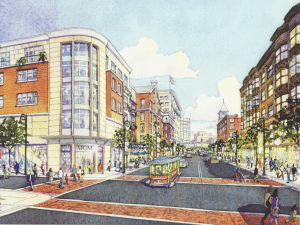
An architect’s rendering of what Springfield’s South End will look like if the planned $800 million MGM Springfield becomes reality. The view is from the south at the corner of Union and Main streets.
As he talked about the proposal, Hornbuckle said the contest to be named the designated Springfield casino project (there are at least two other plans coming together) — as well as the fight that would follow to gain the Western Mass. casino license — will be spirited competitions, and the corporation is ready for what will be a pitched battle.
It has already launched a Web site (www.mgmspringfield.com) that introduces the project and invites input from area residents, and has launched a series of television and print ads announcing the initiative and its role in tornado-recovery efforts. And billboards will soon be appearing with the message: “World Class Entertainment, Gaming, and Dining. HERE.”
“We go hard and fast when we go, and we’re going,” Hornbuckle said. “This is a competition … and we’re in it for the journey.”
Going All In
As he referenced the old image of Springfield’s downtown and its technology-enhanced morphing into a casino site, Hornbuckle said the juxtaposition of images was chosen by MGM and its marketing team to show how the planned casino complex would effectively transform the old into the new.
Actually, it would blend the old — such properties as the old MassMutual headquarters at the corner of State and Main and the former South End Community Center, for example — and new, including a 25-story, 250-room hotel; shops and restaurants; entertainment facilities, including a movie theater and a high-end bowling alley; and new market-rate housing.
It was also chosen to convey that a new era in the city’s history would be unfolding, one that would, in this case, transform an area — the South End — that had fallen on hard times in recent years and then found itself squarely in the path of the tornado that changed Springfield’s landscape in many ways last June.
Overall, the more than 500,000-square-foot, mixed-use development would include the hotel (with amenities such as a spa, pool, and roof deck), 89,000 square feet of gaming space, and about 70,000 square feet of retail and restaurant space that would accommodate 15 shops and restaurants and a multi-level parking garage.
Plans also call for an approximately 130,000-square-foot dining, retail, and entertainment district, tentatively named Armory Square. It would include about 25 dining and retail venues, including a 12-screen cinema, bowling alley, and outdoor stage, on land now occupied by the South End Community Center and the former Zanetti School on Howard Street.Those are two properties for which the city will soon be issuing RFPs (requests for proposals), said Hornbuckle, adding that MGM will need to prevail in those contests if its vision is to become reality. In the meantime, MGM has gained control of several privately owned parcels in the development zone, and has many others under contract.
Plans also include 400,000 square feet of market-rate, one- and two-bedroom apartments, intended for young professionals working in the new entertainment district, said Murren, adding that MGM intends to partner with local cultural institutions, with the broad goal of jump-starting a new era of economic development in Springfield that will radiate out from the project onto Main Street and into other parts of the downtown and the city.
 “I want to build a landmark here, and I want to integrate the assets you have already have — you have great bones here in the city,” he told those assembled at the press gathering. “The job we have is to knit all that together. We don’t want to build a box; we want to build an urban environment.
“I want to build a landmark here, and I want to integrate the assets you have already have — you have great bones here in the city,” he told those assembled at the press gathering. “The job we have is to knit all that together. We don’t want to build a box; we want to build an urban environment.
“We want people to walk up and down the streets, we want people to enjoy themselves, we want people to shop, go to movies, and go bowling,” he continued. “We want families to enjoy being here, and we want people to move back into the city, and I think we can be a big catalyst for all that.”
The blueprint for accomplishing all that will come together by borrowing concepts from existing MGM projects as well as from established retail and entertainment centers, said Hornbuckle, who then clicked to a PowerPoint slide that showed roughly how the complex will come together.
The stretch of the site along Main Street will be devoted to retail, offices, and residential buildings, he explained, adding that the hotel would be constructed along State Street, using the historic building at 73 State St. as the main entrance. Parking would be created along the western side of the property, near Columbus Avenue, and the aforementioned Armory Square would be created between Howard and Union streets.
The casino itself? It would be the middle of all this, said Hornbuckle, adding that it would be essentially invisible to those walking or driving by the site.
“It’s a casino you won’t see,” he explained, adding that MGM Springfield is being designed with the casino as just one part of the experience.
“What’s critical about the design is that you can interact, whether it be the hotel, the gaming, the entertainment, or up on Main Street, without having to go into the casino,” he noted. “We’re not forcing you to into that environment; if you want to bring a family to enjoy this, you can. That’s a critical element, especially for an urban casino.”
Both Murren and Hornbuckle stressed that no indoor entertainment area is planned for MGM Springfield. Instead, the company plans to partner with existing facilities such as the MassMutual Center, Symphony Hall, CityStage, and local museums, including those at the Quadrangle, to help drive traffic to those facilities. To that end, a pedestrian bridge has been proposed to link the MGM complex with the MassMutual Center.
Placing Their Bets
Several times during his address to those assembled at the press gathering, Murren said that event marked the start of a conversation, or dialogue, on the company’s plans to take its brand into downtown Springfield.
That dialogue will continue over the next several months as MGM’s plans are finalized and rival plans join the competition for the Western Mass. license.
But company officials already believe they have a winning hand, and they’re betting heavily that the community — not to mention the state’s Gaming Commission — will feel the same way.
George O’Brien can be reached at [email protected]
Pittsfield Strives to Generate Interest in Business Park at GE Site
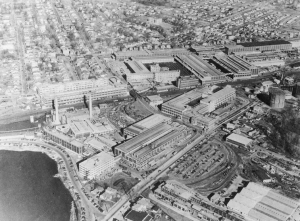
Above, the GE Pittsfield Works in 1946. At top, an aerial shot of the portion of that same property that has become the William Stanley Business Park.
Stanley, a long-time engineer with Westinghouse, created his prototype in 1886, in Great Barrington, but his concept, which made it possible to spread electric service over a wide area, would most dramatically change the landscape — and in many different ways — in nearby Pittsfield. It was there that he started the Stanley Electric Manufacturing Co., the venture eventually purchased by General Electric and later renamed the GE Pittsfield Works, a sprawling large-transformer-manufacturing complex that, at its height in the 1960s, employed more than 13,000 people.
Today, Thurston, executive director of the Pittsfield Economic Development Authority (PEDA), is hoping that innovation can again transform this property near Silver Lake more than a quarter-century after GE announced that it was closing the massive plant. The 52-acre business park, created on roughly a dozen various-sized parcels, transferred to the city by GE in recent years, officially opened in early June with a ribbon-cutting ceremony at the Mountain One Financial Center in a corner of the property off East Street.
The facility, a 6,735-square-foot, LEED-certified structure dominated by glass, is catching the attention of the city and the region, said Thurston, who is confident that it will also capture the imagination of the business and development communities, and eventually help repopulate the mostly barren acreage with a broad mix of businesses.
“It showed the naysayers, who didn’t believe anything would ever happen here, what can be done,” he explained, adding that the quick timeline for the project — it was announced in April 2011, ground was broken that August, and construction was completed on March 30 — demonstrates how the city is committed to making things happen on the property.
Moving forward, one possible catalyst for redevelopment could be a planned 20,000-square-foot life-sciences building, said Thurston, adding that the venture could be funded through a $6.5 million earmark granted to Pittsfield as part of the Commonwealth’s Life Sciences Bond Bill.
Intended as a stage-two facility for companies looking for room to get to the next stage, the 20,000-square-foot center would be a facility that could house and foster the kind of innovation that gave the park its name.
Beyond that initiative, though, the park could become home to anything from retail to light industrial; from green-energy ventures (there’s already a 1.8-magawatt solar power array on the property) to municipal facilities.
“We’re optimistic,” said Thurston. “Typically, in the Northeast, 70% of your economic development comes from within, from expansion of companies in the market already. We’re focusing quite a bit on making sure that our existing businesses have opportunities to grow, while we’re also looking at other options such as government facilities.”
There are a number of challenges involved with redeveloping the former GE complex, said Thurston, listing everything from the stigma attached to brownfield sites, even though this one has been cleaned, to competition in the form of perhaps 1 million square feet of former mill space in Berkshire County vying for the attention of startups and established businesses alike. But he is optimistic that the park can soon become a center for both innovation and jobs, as it was decades ago.
“We believe that this is a model for cooperative remediation and redevelopment efforts across the country,” he told BusnessWest while looking over a large aerial photograph of the GE complex taken decades ago. “There is enormous potential here.”
For this issue and its focus on commercial real estate, BusinessWest ventured to Pittsfield to learn how officials there hope to transform the landscape in this section of the city and, in some ways, have history repeat itself.
Current Events
Thurston said it’s difficult to quantify or even qualify the impact GE’s operation had — and still has — on the city.
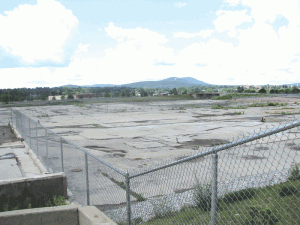
This view from the northeast shows some of the vast open space now available for redevelopment with the transfer of the former GE property to the city of Pittsfield.
And part of that reinvention is the redevelopment of the property on which Stanley Electric and then GE operated for close to a century, a project that has been ongoing for more than 13 years now and is defined by both challenges and opportunities.
Fast-forwarding through the years since a definitive economic-development agreement between GE, the city, the Environmental Protection Agency, and other parties was inked, Thurston said the 52 acres now under PEDA’s control have been remediated and transferred to the city for redevelopment. The pace of progress has often been frustratingly slow — the last parcels were not transferred until earlier this year — but significant momentum has been generated in recent months.
Standing outside the front door of PEDA’s office on Kellogg Street, which has a commanding 360-degree view of the site, Thurston hit the highlights. Pointing to his far right, toward Silver Lake, he referenced the solar installation completed by Western Mass. Electric Co. in 2010, as well as Mountain One’s project.
Turning to his far left, he pointed out a large 16-acre parcel on which several GE buildings once stood. It is, to the best of Thurston’s knowledge, the largest open, developable (“unimpeded” was the word he chose) tract in Pittsfield, and land that could be subdivided any number of ways to suit the needs of developers.
And, sweeping his hand to the right, he pointed out Woodlawn Avenue and the now-closed bridge (built in 1906) over the railroad tracks that run through the middle of the complex. The street, formerly a private way that bisected GE’s plant, will be repaired and made a public road, and a new bridge will be constructed by the state, said Thurston.
“This will hopefully be a real catalyst for our rebuild,” he said, noting that the site, hemmed in by residential neighborhoods and narrow, winding side streets, will need a secondary form of access in the form of an open Woodlawn Avenue to reach its full potential. “Finishing up these key infrastructure pieces is very crucial for us and our ability to put a large manufacturing facility or retail center that employs a large number of people on one of these sites.”
As he talked about that process, Thurston said the plan has several basic components, all designed to increase awareness of the site and its many amenities, and then bringing prospective tenants to PEDA’s door.
At present, the city is conducting some target marketing, while also working to connect with a host of public and private partners on the project, he continued, noting that this constituency includes a number of players.

Cory Thurston, seen in front of a map of the new business park, says the site has amenities that could attract ventures from across several sectors of the economy.
Meanwhile, another potential partner, and major asset, as Thurston described it, is CSX Corp., which has a rail line that runs through the middle of the site and, with Woodlawn Avenue, creates four sectors of redevelopment.
“We’re working with their economic-development team to identify rail-friendly tenants that might be interested in an opportunity in downtown Pittsfield,” he explained. “They’re in a large growth mode, and rail service could be an important factor in drawing people to this site.”
Watts Next?
PEDA and these various partners have what Thurston considers a very salable product, one with amenities attractive to businesses in a variety of sectors.
At the top of this list is developable land that is in many cases ‘shovel-ready,’ a technical term used to describe land that is clean, fully permitted, and, as the phrase suggests, ready for a shovel.
Other parcels don’t quite fit that description, said Thurston, listing that aforementioned 16-acre parcel, for example, which has elevation changes and old foundations as the primary but still minor challenges to be overcome.
Another amenity, he told BusinessWest, is location, which is driven home in promotional aerial photographs of the site that prominently feature Crystal Lake and the nearby Berkshire mountains.
Beyond scenery, though, Pittsfield is located roughly halfway between Albany and Boston, said Thurston, and thus could be an attractive option for emerging technology and life-sciences companies operating or doing business in both markets. There is also the Berkshires’ still-affordable high quality of life, he went on, adding that this mix of selling points should turn some heads.
However, there are some challenges as well, including an economy still in recovery mode, that aforementioned stigma about brownfield sites, especially one with such a high profile, and a huge glut of former mill space in Pittsfield and surrounding communities that offers an attractive alternative to business owners, and one that usually carries a lower price tag than new construction.
“We’re confronting the same challenges being faced from a manufacturing and industrial perspective across the Northeast,” he explained. “New construction is difficult, and we have a lot of wonderful facilities in Pittsfield and across Berkshire County, like some of the old paper mills that have been repurposed, where businesses can grow and expand; there’s a lot of competitive real estate that still stands.”
But overall, Thurston believes the business park is the proverbial right place at the right time, and he thinks the planned life-sciences building is a potential-laden project that could drive that point home, while also creating some potential future tenants.
As currently conceived, the center would go beyond a typical incubator, providing next-stage companies with the shared lab space, broadband capacity, and other amenities needed to make that jump to where they’re ready to begin production and take on employees.
“This would be a nice, low-cost, quality-of-life facility that they could move their venture to and continue their growth and development,” he said, adding that the next phase in the project is convincing the state to release the earmark, a process that is already underway. “We want to create something new and exciting in Pittsfield.”
Overall, PEDA will be patient with the broad redevelopment process, said Thurston, adding that, in every way possible, it will “leave its options open.”
That sentiment applies to everything from potential reuses — the site has been mentioned as home to everything from retail complexes to municipal facilities, including a new courthouse and police station — to individual parcels.
Indeed, while it is likely that the 16-acre parcel mentioned earlier will be subdivided, PEDA will not do that until options for one larger user have been explored and exhausted.
Getting Amped Up
While it’s extremely unlikely that the former GE site will again be home to 13,000 jobs, said Thurston, the business park created there has vast potential to again play a lead role in shaping the economy of Pittsfield and the surrounding area.
What that shape will be is anyone’s guess, he noted, adding that it will take years to fill in the canvas.
But the process is well underway, momentum is building, and there are clear signs that this facility can live up to the name it’s been given.
George O’Brien can be reached at [email protected]
Downtown Initiative May Prove to Be a Unique Stroke of Genius
Evan Plotkin says the ninth floor of One Financial Plaza had been “dark” — that’s a commercial real-estate industry term synonymous with vacant — for more than six years.“With a few exceptions, no one had been in there, except for maintenance people, in a long, long time,” Plotkin, co-owner of the building and president of Springfield-based NAI Plotkin, told BusinessWest, adding that things have changed dramatically over the past month or so, and in a way that bodes well for Springfield and its downtown.
Indeed, roughly one-third of the ninth floor is now the exact opposite of dark, and while this space hasn’t exactly become a tourist attraction — not yet, anyway — a large and diverse group of people have hit that button in the elevator over the past several weeks. Many city officials have made the trek, as have many UMass trustees and administrators, including new president Robert Caret and recently named Amherst campus Chancellor Kumble Subbaswamy. The city’s police chief, William Fitchet, has been up for a look, as have a number of Plotkin’s friends and lovers of art.
They’ve come to see a unique collection of paintings, sculptures, and other works of art assembled by John Simpson, manager of the Hampden Gallery at UMass Amherst and an art professor in the Commonwealth Honors College at the university. Many of these same works had been occupying space — meaning that, in many cases, they were leaning up against walls, often back-to-back — in a gallery/theater in the old Hampden Dining Commons in the Southwest residential area at the university.
When Simpson was essentially evicted from that space by the building inspector several months ago, he launched a frantic search for alternative accommodations in which he could display art and create more of it. Before he really got started, Plotkin, who has been at the forefront of efforts to use art to stimulate economic development in Springfield, offered him a good chunk of the ninth floor free of charge.
It was, as they say, a deal he couldn’t refuse, and what the two men have created is intriguing on myriad levels.
Starting at the elevator doors, art abounds, ranging from self-portraits of the Commonwealth College students who created many of the works on display to various pieces that were part of a display on Egypt that Simpson helped create for the Springfield Museums nearly a decade ago.
But as they look out on all this art, both Plotkin and Simpson see something else — opportunities that come in many forms. These include the ability to demonstrate the potential for art to bring attention, energy, and vibrancy to a city or downtown, as well as a chance to show the leaders at UMass how an expanded presence in Springfield, something city leaders have desired for some time, could benefit both the school and the community.
“I like to say that we’ve planted a seed,” Plotkin told BusinessWest. “We’re watering it, we’re going to nurture it, and hopefully at some point in time this will grow into something bigger.”

The ninth floor is crowded with an eclectic mix of art, including this piece from an exhibit on Egypt at the Springfield Museums.
“We’re hoping that someday, UMass will plant its flag here,” he said, “and that some component of the university is located here. We have serendipitously gone in this direction, and now we have something wonderful that we can build on.”
For this issue, BusinessWest talked with Plotkin and Simpson about what they’ve done in One Financial Plaza, and also about how they expect that seed that’s been planted to germinate and yield something special.
Brush with Fame
Printed over one of the entranceways to the ninth floor from the bank of elevators is a famous quote from author John Updike: “What art offers is space — a certain breathing room for the spirit.”
In this case, though, it was the need to create physical space for the art in question — not to mention breathing room for Simpson — that provided the first compelling chapter of a story that could unfold in any number of ways.
For now, it’s a tale of new life for formerly dark square footage, or an opportunity, as Plotkin put it, to “activate” more space in Springfield’s downtown. He’s been using that term often in recent years, always in reference to taking facilities that were dark — in either a literal or figurative way — and putting them back into use, or better use.
Examples include everything from the revamped plaza area at 1550 Main St. (the former federal building) to the park-like spaces within the Morgan Square apartment complex further down Main Street, to the lobby of One Financial Plaza, which has become an art gallery of sorts in recent years. Meanwhile, many buildings and open spaces downtown have been further activated by the placement of many works created by local artist James Kitchen. His welded-metal creations, such as the massive ‘Saturn’ now gracing the small park created on the former Steiger’s lot, adorn many public and private spaces as part of another initiative spearheaded by Plotkin.
How the ninth floor at One Financial Plaza came to join that list is a saga that began when Simpson was turned out of his space at UMass.
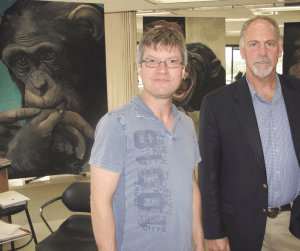
Evan Plotkin, right, with John Simpson, equates his activation of the ninth-floor space to “planting a seed.”
The university has been cooperative in trying to find alternative arrangements, Simpson went on, but in the meantime, Plotkin offered something more immediate and potential-laden, in a building that has made great strides in recent years in terms of reducing a high vacancy rate, but still has several vacant floors.
“Pushing us out of Hampden created this opportunity to display all these years of work by the students, making it a living thing,” Simpson explained. “So people can make things and at the same time look at these previous accomplishments, and learn how to do their own.”
In less than two months, Simpson and some of his students have transformed a large portion of the ninth floor from a dark, cold (figuratively) place with peeling wallpaper in many places into an oasis of art worthy of that Updike quote.
There is ample gallery and reception space, with walls crowded with paintings and other art forms, most of them created by Commonwealth Honors College students who are not art majors, but have created art that somehow expresses their chosen field of study. There is also a large studio — formerly the cafeteria for the most recent tenant, UniCare — that boasts the large amount of natural light that artists require.
The Shape of Things to Come
The donation of the ninth floor for the foreseeable future solves Simpson’s immediate need for space, said Plotkin, but it also provided a significant opportunity for more of that “activation” work that he described.
“We’ve been successful in using art as a vehicle to transform space, and now it’s happened again here,” he said, gesturing with his hand to the art all around him. “This floor was vacant and dark for more than six years; now, it’s alive with energy.”
Simpson and Plotkin said the eclectic collection usually draws a one-word response from those seeing it for the first time — ‘wow.’
“Their jaws just drop,” said Plotkin, who has taken many friends and business associates through the space, which was also visited by many of those attending a pre-concert gallery opening and reception in the lobby of One Financial Plaza. The works hanging there, created by Commonwealth Honors College students, were inspired by Gustav Holt’s The Planets, which was performed that night by the Springfield Symphony Orchestra.
But while the present picture is drawing positive reviews, it is the prospects for the future that Plotkin, Simpson, and others find most intriguing. And speculation comes on many levels.
For starters, those involved with this project see the ninth-floor space as a possible site for events and fund-raising initiatives, and they speculate that it could someday be open for public visitation. They also see the strong possibility of collaborative initiatives with area schools, with the gallery and studio space providing unique learning opportunities for young people. Meanwhile, they also see it as a potential catalyst for more artists to seek to work and perhaps live downtown.
“This is where the business world and the art world intersects, and in a way that allows that revitalization thing to happen,” Plotkin said of what he believes is taking place at One Financial Plaza. “People can see this through all the things we’re doing in this building — it’s an example of what can happen.
“It’s like a test tube,” he continued. “We’ve created this environment, and people are looking at it as a microcosm of what can take place on a larger scale.”
And, on an even bigger scale, they see this collaboration as a possible springboard for creating a larger UMass Amherst presence downtown, one that might include a satellite campus, but also perhaps housing for students, which Plotkin described as a potential catalyst for further growth and new business development in the central business district.
“Everyone who’s talked about economic development has touched on the importance of creating student housing downtown,” he said. “Westfield State University has done this, and it has helped to re-energize economic development efforts in that city.”
Meanwhile, he believes that what has been created at One Financial Plaza can serve as an effective recruitment tool for UMass, as potential students see art created by others and hear how it has helped them gain confidence and resolve.
“The narrative here is that these very bright kids, many of whom didn’t know they had any artistic ability, discovered themselves,” he explained. “It’s incredible, it’s profound, and it’s enormous in its scope when you look at the quality of this work.”
Art of the Matter
As he looked around the ninth floor, Plotkin shook his head a few times while attempting to sum up all the possibilities.
“There is so much that can happen here — and also happen elsewhere because of this,” he explained. “As this matures, we’re hoping UMass can find the funds to have this fulfill all of its vast potential.”
Whether this will happen, and when, remain to be seen, but for now, what’s important is that the seed has been planted.
George O’Brien can be reached at [email protected]
Strong Interest Projected for the Former Asylum Nightclub Building
Kevin Kennedy says the original plan for what has long been known as the Asylum nightclub building in Springfield’s downtown was to take the property with the checkered past — there were a number of controversial all-night concerts there before the building was eventually shuttered due to safety concerns — and give it a new use as home to public offices.In fact, his large department, Planning and Economic Development, or parts of it, was among many possible public-sector tenants that became part of the discussion when it came to the Asylum’s future.
But that was a few years ago, said Kennedy, the city’s chief development officer, noting that many positive things have happened in the interim that have prompted him to change his perspective on the now-renovated Asylum property. Indeed, a number of success stories, including the redevelopment of 1550 Main St. (the former federal building), the pending arrival of Thing5 and 300 new jobs in One Financial Plaza, plans for WFCR-AM to move into the Fuller Block across Main Street from the Asylum property, and other developments, have prompted Kennedy to believe there is strong private-sector interest in the building and its 21 on-site parking spaces.
He’ll find out just how much over the next several weeks as the city first issues a request for proposals (RFP) for development of the property’s 6,000 square feet, and then awaits responses.
He believes there will eventually be many to consider.
“I think there will be an active market for that building,” he told BusinessWest, adding that he considers commercial office space the most likely — and desired — reuse of the property. “Downtown is changing — for the better — and this could be another big success story there.”
Recounting the recent history of the Asylum building, Kennedy said that, as MassDevelopment proceeded with plans to revitalize and retenant the former federal building, the city knew it had to do something with the troubled property across Worthington Street from 1550 Main St.
The eventual plan conceptualized by the control board that was essentially running the city at that time was to raze all but the 6,000 square feet fronting Main Street, and create parking, as well as space for community events, on the demolished portion of the property.
And those plans were carried out over the past year in a $1.6 million initiative, funded with state and federal money, that included façade work that includes new signage that essentially renames the property 1600 Main Street.
The original intended tenants were public-sector entities, said Kennedy, adding that the Business Improvement District, the Springfield Parking Authority, and the Planning and Economic Development Department (currently located on Tapley Street) were all considerations.
But with those aforementioned positive developments downtown in recent months, those plans changed.
“When I came to this office [in December 2011], I took a look at the changing conditions in the downtown, with Thing5 coming in, the revitalizing of 1550 Main, the work that Herbie Flores [president of the New England Farm Workers Council] was doing on the blocks immediately adjacent to it, WFCR, progress in Morgan Square, and other developments, and came to the conclusion that we should RFP this for private use.
“That would enable us to get it back on the tax rolls,” he continued, “and that makes far more sense than public-sector use.”
And Kennedy believes there will be considerable interest from the private sector, especially with nearly two dozen on-site parking spaces, an attractive selling point to companies who might consider a downtown mailing address but have been hesitant to locate or relocate downtown due to concerns about available, convenient parking.
“Having 21 spaces adjacent to the building should help create a strong market for the property,” said Kennedy, adding that the RFP includes plans to locate a public market in that parking area on Saturday mornings.
Kennedy acknowledged that it’s difficult to forecast the level of response to an RFP — some recent projects have drawn considerable interest, while others, such as the former York Street Jail, failed to capture the attention of the development community — but he anticipates several proposals due to the strong combination of location, amenities, and the momentum gained in that part of downtown over the past several years.
Time will tell if Kennedy’s optimism about the site is fully warranted, but at the moment, he’s quite confident that the property’s reuse and return to the tax rolls will become part of that list of positive developments along Main Street — and perhaps prompt still more additions.
If it does, then it is likely that the city can retire that phrase ‘Asylum building,’ something it’s been trying to do for many years now.
George O’Brien can be reached at [email protected]
Chicopee Crossing Will Complement Booming Growth on Route 33
At the front of a large, open plot of land on Memorial Drive in Chicopee, just south of Mass Pike exit 5, is a lone Chipotle Mexican Grill — and nothing else.But judging by the volume of cars pulling in each day, Frank Colaccino has to be optimistic about the prospects for the rest of that open space, which he has dubbed Chicopee Crossing.
“I was surprised that Chipotle has such a following, but they do a very, very good job,” said Colaccino, president of the Colvest Group in Windsor, Conn., which is developing the site. And other restaurants and retailers should see value in joining Chipotle there, he added.
“It’s so accessible — you have access right off the Mass Pike and from Route 33, a major street with a high traffic count — and you have a lot of traffic generators around there, from a Wal-Mart to a Home Depot to Stop & Shop, Big Y, and a BJ’s Wholesale Club. That’s a lot of retail attractions, and we’re right in the middle of all those traffic generators.”
The process of developing Chicopee Crossing began in 2009, but had to clear a major hurdle first. Namely, the city had to find a way to allow northbound drivers on Memorial Drive — separated from the southbound lane by a guardrail — access to the property.
“The access was only on one side of Route 33,” Colaccino said — and with plenty of other retail and restaurant options at the next few busy intersections, none of them allowing U-turns, it was unrealistic to think northbound drivers would make the effort to reverse course for Chicopee Crossing. “To make this an attractive site for retailers, we had to put a traffic light in, and in order to do that, we had to go through the state, through Mass Highway — because it’s a state road — and get their permission.”
That process, he noted, took about 14 months, and involved input from several different agencies. “But that happened, and we’ve put in the traffic signal. It’s installed and operating.” The intersection allows not only left turns into the development, but also access from across the street, where a host of other retail ventures have sprung up over the past decade, and where an Aldi’s supermarket will be built later this year.
While the intersection issue was working its way to resolution, infrastructure for Chicopee Crossing — from water and sewer drains to electric installations and road paving — were being completed, and Colaccino expects construction work to begin in earnest early this summer, following commitments by tenants.
The one building already erected, the 7,000-square-foot structure which currently houses Chipotle, will soon have two other tenants to fill its remaining space: Great Clips, a national hair-salon chain, and a national telephone store. Three other buildings of similar size are also planned; they’re expected to be a second fast-food restaurant, a family restaurant, and a bank. Behind those will be a three-story office building and a 40,000-square-foot retail complex.
Further back will be a Marriott Courtyard hotel. That portion of the project is owned and being developed by Dennis Patel of BK-Investments.
“We’re starting to see some more activity out there,” Colaccino said regarding interest from potential tenants at Chicopee Crossing, “so we’re optimistic that something will happen soon.”
Setting Their Sites
Chicopee Mayor Michael Bissonnette said last year that the key event in bringing Chicopee Crossing to reality was a financial commitment by the state — specifically, $1.25 million through the Massachusetts Opportunity Relocations and Expansion Jobs Capital Program — to pay for the construction of the new intersection, allowing access from both sides of the Route 33 and connecting the new development with the former Casey Chevrolet (and future Aldi’s) property.
“It’s a great project, and it’s going to have the best access off the Pike of any piece of land in Western Mass.,” said Kate Brown, Chicopee’s Planning Department director. “I guess we’re hopeful, now that the economy seems to be picking up, that we’ll see more activity in that location.”
In particular, she noted, the hospitality industry was sluggish during the Great Recession, casting caution over any new hotel project, so it’s encouraging to see the Marriott Courtyard, and all the other proposed elements of the development, coming together.
As for other retailers and restaurant chains that might be feeling out the property, “I can certainly see that site as a draw because the hotel won’t have a restaurant facility,” Brown added. “So it’s kind of a captive audience.”
Any new additions would join a flood of retail and restaurant ventures that have sprung up along Memorial Drive just north and south of the Pike entrance over the past few decades.
The former Fairfield Mall property across the street was the most significant recent development; after those buildings were torn down in 2002, they were gradually replaced by a Home Depot and a Wal-Mart Supercenter. Those, in turn, anchor a plaza that now includes a Marshall’s, Staples, 99 Restaurant, Applebees, and about a dozen smaller retailers and quick-service eateries; a Friendly’s at the south edge of the site is the only survivor from the mall years.
Yet, Brown said the corridor began to pick up even before that, around 1996, with a series of smaller store openings. Since the mid-’90s, “if we had a vacant spot, we’d have a building on it quickly. It’s been pretty amazing. I wish we had more land there, actually. We were kind of skeptical that the stores located in the [Wal-Mart] shopping center would be viable, but it’s been a very stable group of businesses.”
Colvest, which has built a solid portfolio of projects in Western Mass., from several CVS locations to a new office complex on East Columbus Avenue in Springfield, has never taken on this kind of mixed-use project before, Colaccino told BusinessWest, but he’s excited about the potential for this particular site, for the very reason others mentioned — the fact that exit 5 has become a significant retail destination.
“I think this is a prime mixed-use project, with everything that’s here,” he said, adding that he has enjoyed working with Chicopee officials on bringing the development to the verge of the construction phase.
“All the people I’ve worked with in the city of Chicopee have been terrific,” he noted. “Mayor Bissonnette has been great to work with, and they have been very cooperative.
“They have a system in Chicopee,” Colaccino continued. “When a developer comes in, they get all the various departments together to talk about all the issues that might come up and all the different needs they have and what the developer has to do. They really make the process streamlined, and you don’t have to guess at everything. They just tell you, ‘these are the requirements,’ and we work together to make those things happen in a way that’s beneficial to everybody.”
Bottom Line
Nothing will happen — except for the hotel, of course — without commitments from tenants, and Colaccino expects those to be firmed up in short order so that construction can proceed this summer.
“We won’t build on spec,” he said, not even the office building. “But we envision some demand for office space there, and when that comes in, we’ll be ready. I think we’re envisioning some 22,000 to 25,000 square feet of office space, and that could be any number of uses — a doctor’s office, a dentist’s office, it could be a professional office, a mixed office with medical … any number of things.”
In any case, construction workers will be digging for drainage and other underground work very soon, and the hotel foundation will follow. After that, “we wait for the tenants,” Colaccino said, conceding that he’s anxious to see that phase move swiftly. “It doesn’t do us any good to have land just sitting there.”
Joseph Bednar can be reached at [email protected]
Enterprise Center Has a New Lease on Life
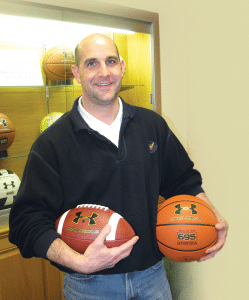
Dan Touhey, a partner in psi 91, which develops and distributes inflatable products for Under Armor, is one of many new tenants in the Springfield Enterprise Center.
Marla Michel acknowledged that Square One is not exactly the kind of tenant that the creators of the Scibelli Enterprise Center, a business incubator, had in mind when they opened its doors more than a dozen years ago.
The provider of early-childhood-education programs and related services is certainly not a startup (in fact, it’s one of the oldest businesses in Springfield), and it’s not a fledgling outfit looking for advice and technical support on how to get to that proverbial next level — two variations on the desired-tenant profile.
But the institution needed office and operations space after its headquarters and other facilities on Main Street were destroyed in the June 1 tornado, and the Technology Park at Springfield Technical Community College, as well as the so-called SEC, which is part of that complex, provided an attractive, accessible, and affordable option.
“So by taking seven suites in the SEC, Square One has helped forge a classic win-win scenario,” said Michel, the SEC’s director, adding that the company moves into centrally located Class A space not far from where it was before, while the enterprise center gains what she called “much-needed breathing room.”
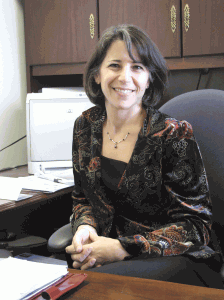
Marla Michel says Square One’s arrival at the SEC provides the facility with much-needed breathing room to conduct strategic planning.
Companies like psi 91, which moved in just over a year ago.
Started by two former Spalding executives who opted to stay in the region when the corporation left Springfield for Kentucky in 2009, the venture — which takes its name from its function (inflatable products and their unit of measure, pounds per square inch) and its location, off the interstate — develops and distributes products for apparel maker Under Armor. A basketball and football were brought to the market last year, its first in operation, and a volleyball and soccer ball will follow later in 2012 (a rugby ball is also in the works).
There’s also Tickets for Groups, which, as the name suggests, serves groups of 15 or more looking for tickets for everything from Rockettes performances to the current traveling show known as “Bodies: the Exhibition,” touted as a celebration of the human form. Deb Axtell, who started the venture after working as director of group sales for Radio City Music Hall and then Disney Theatricals, and moved into the SEC in 2010, said the King Tut exhibit that was in Discovery Times Square for several months before recently returning to Egypt was a “home run” for the company, and she’s looking for the another show that will fit that description.
Another recent arrival is Barkley Logistics, a third-party logistics company owned by Robin Sauve, that arranges the transportation of shipments between two points, with palletized freight — usually much less than a truckload — comprising much of the business volume. There is a separate division, called My Luggage Valet, which will do the same thing with suitcases, golf clubs, and other items that one may not want to trust to an airline.
The most recent addition, meanwhile, is Sanitas Solutions, a technology partner focused specifically on helping individual physicians and practice groups make the transition to electronic medical records.
To attract more ventures of this type and thus secure long-term sustainability for the SEC, Michel is preparing what amounts to a new strategic plan. As part of that process, the college has hired a consultant, Jim Robbins, a noted expert on business incubators and innovation clusters, to help develop a game plan for the facility as well as implementation processes.
Summing up what Robbins has told the college thus far, Michel said he’s suggested strongly that it undertake revenue-diversification efforts, meaning more income streams — “right now, what we have is the state [through the college] and rent, which is a model that’s not sustainable,” she explained. Also, he has suggested a more regional approach to marketing, greatly increasing the number of incubator tenants, and also providing services outside the walls of the SEC to make it more of a regional resource.
“Once we take location off the table and start shoring up the services an incubator provides, that an enterprise center provides, we can potentially have a much larger economic impact,” she explained, adding that successful incubators around the country have both ‘resident’ and ‘non-resident’ programs, and the SEC will look to emulate those models.
What’s In the Cards?
Like most people in business and education (she’s in both, technically), Michel, who splits her time between the SEC and UMass Amherst, where she serves as executive director for economic development and regional partnerships, has a stack of business cards on her desk. Only, her stack is unlike almost any other.
Her cards are what she calls “three-dimensional.” They fold into small, four-sided cubes, many of which she has sculpted into a multi-level tower. Printed inside the cube are the words ‘business’ and ‘building,’ which, depending on which order they’re arranged, explains both what the SEC is and what it does, said Michel.
And moving forward, it would like to put much more emphasis on the latter half of that equation, and this explains why Square One’s move to the facility is so important.
In recent years, the SEC has suffered from high vacancy rates (near 50% at the low point) that have stemmed from several factors, but mostly the sluggish economy and a lack of aggressive marketing, said Michel. She noted that her initial focus when she arrived 20 months ago, as part of a cooperative agreement between the college and the university, was much more on filling space than the mission of incubating fledgling companies.
Indeed, not long after she took the helm, college administrators gave her the go-ahead to bring in tenants that were non-incubator-related, with the over-arching goal of lessening the financial burden imposed by the center on the college.
She’s added several companies and agencies that fit that description, one of many initiatives designed to help position the center for a stronger, more impactful future when it comes to economic development and all-important job creation.

Deb Axtell, owner of Tickets for Groups, says many SEC incubator tenants leave kicking and screaming — and she intends to do the same.
Meanwhile, she’s also been building what she calls “business clusters” within the center. There are now three of them — Cleantech, IT, and Education, and the hope is that a growing critical mass will help attract other ventures in each category.
With these and other efforts, as well as the relocation of Square One following the tornado, Michel has built up occupancy to near capacity, with tenants falling into four categories:
• Incubator Clients, now totaling six, including psi 91, Tickets for Groups, and Barkley Logistics;
• Anchor Tenants, including the Mass. Small Business Development Center Network, SCORE, and the Small Business Administration;
• SEC Tenants, or non-incubator clients, including Square One, Alliance Medical Gas, CTC Electric, the Achievement Network, and the Veritas Preparatory Charter School; and
• STCC Tenants, or agencies related to the college, such as T.W.O., the workforce-training initiative undertaken in collaboration with Holyoke Community College, and the MassGreen Initiative, a program designed to train people for jobs in green-energy businesses.
The goal moving forward, Michel said, is to gradually increase that number of incubator tenants, but also enable the SEC to have a greater impact on economic development through both resident and non-resident programs aimed at helping ventures survive their first few years in operation and stay in business rather than failing or selling out.
“Our region is lacking services that help companies that are already in business,”she explained. “We have a fair amount of services for those who want to get into business, but when they’re in business, we have to make services more accessible that will teach companies how to grow rather than sell.”
At the moment, she focused on steps ranging from more aggressive marketing of the square footage to simply telling the stories of the people who now have a business address of 1 Federal St., Building 101.
They are all unique, but with several common denominators, including, in many cases, a need and desire to have a place to bring potential clients other than the corner Dunkin Donuts.
A Fortuitous Bounce
Such was the case with Dan Touhey, a former sales executive with Spalding (and BusinessWest 40 Under Forty winner) who opted not to relocate his family when the corporation that owned the sporting-goods maker moved it to Kentucky.
He took his career in a few directions, including a stint in business consulting and an assignment teaching management at UMass, where he met Michel. Later, after he and former Spalding colleague John Frank decided to launch psi 91 together, Touhey asked Michel if the partners could use one of the conference rooms in the SEC to meet with Under Armor executives.
“We had been meeting at Panera Bread or wherever we could grab a cup of coffee, and it just wasn’t working for us to have confidential conversations in that environment,” he told BusinessWest, adding that, to make a long story a little shorter, he and Frank inked their first contract in that conference room and shortly thereafter decided to move into the SEC. Meanwhile, Michel created a new policy whereby any pre-revenue-stage company can use the conference room at the enterprise center.
Just over a year after opening, Touhey and Frank can claim a number of success stories. For example, if one was to look really hard — and past the new (and many would say garish) uniforms worn by the University of Maryland football team last fall — he or she would notice that the team’s offensive unit uses an Under Armor pigskin.
“That’s how it works in college football — the offensive team can decide what ball it wants to use,” said Touhey, adding that several squads that wear Under Armor apparel are now using its footballs and basketballs as well.
“The beauty of our relationship with Under Armor is that we can come under the umbrella of the master brand of that company,” he explained. “And they have a very strong relationship with about 15 colleges and universities; for example, the University of Maryland is an all-Under Armor school, and it used our football last year.
“In basketball, it’s a little different; you play the ball the home team decides to use,” he continued. “If you go Auburn, Texas Tech, Towson University, LaSalle, Lamar, the University of Utah, and others, they’re playing with our basketball.”
The company has added staffing, including other former Spalding employees, and is already tight on space in its 635-square-foot facility. Touhey anticipates that psi 91 will have to move to larger quarters sometime in 2013, an eventuality he’s not looking forward to, because he likes the building, gains from the expertise of Michel and others, and enjoys sharing war stories with other entrepreneurs.
Axtell can relate. She’s not looking to move out either, although she understands that ‘graduation,’ as it’s often called, is part of the incubation process.

Robin Sauve, owner of Barkley Logistics, says one of the main benefits from being an incubator tenant is being able to learn from people who have “been there and done that.”
She eventually moved into a tiny office in East Longmeadow and quickly outgrew that. Thus commenced a search for larger and better quarters that ended at the SEC; she moved in just before Michel arrived.
She told BusinessWest that she’s now up to six employees — four in the SEC, and two who work out of their homes in New York — and is in the process of “taking a snapshot” of her business and writing a new five-year plan.
Meanwhile, Sauve is focused more on crafting a two-year plan for Barkley Logistics, which she created not long after Premiere Logistics, which she served as vice president of business administration before it lost its line of credit, then its reputation, and then most of its customers.
She bought the equipment (mostly hardware and software) used by Premiere, and, seeking a clean break from that venture, started Barkley Logistics, which has been growing steadily since its formation, thanks in large part to support from the panel of advisors assigned to the company as part of its incubation experience.
“There’s an enormous sense of affirmation when you’ve met with people who have been there and done that,” she explained. “The people on my panel, designed to meet my specific needs, have been instrumental.
“As much as I have a general business-management background, I’m not an accountant,” she continued, noting that there is one on her panel who has been helpful with the many financial aspects of operating the venture. “The same with marketing — I’m not an advertising person, so some of the tips I’ve been given on that have been tremendous.
“Just hearing from other people who have run their own business and been through many of the same things I’m going through is a great benefit,” she went on. “It’s comforting to hear them tell me I’m on the right track, and also to know that, if I was doing something wrong, they’d be the first to let me know about it and steer me back in the right direction.”
Room for Improvement
Axtel told BusinessWest that she knows how it’s supposed to work in a business incubator.
“You’re supposed to get the support you need, spunk up, and then you’re thrown out,” she said. “I’ve heard stories that people exit here kicking and screaming, and I hope to be one of those.”
But exit she will — eventually — because, while the SEC is indeed a business building, the focus for the future will be more on what the facility does. And with that in mind, Michel intends to take full advantage of the breathing room that she’s been given.
George O’Brien can be reached at [email protected]
Holyoke Project is a Study in Perseverance
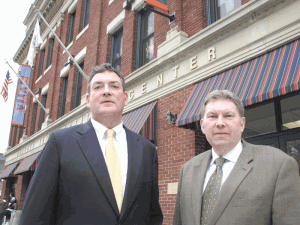
Mike Crowley, left, and Bob Schwarz in front of the Holyoke Transportation Center, a unique project that overcame innumerable hurdles.
Mike Crowley says that from a strict bottom-line perspective, the initiative that became known as the Holyoke Transportation Center never really made complete sense, and always came complete with a large amount of risk.
Indeed, when asked when and if this unique commercial real estate venture will become a financial success, Crowley laughed and then offered an expression that seemed to say, ‘who knows?’ — a reaction that essentially told the story. Well, not really.
That’s because this project was never about economics — or all about economics, said Crowley, a commercial real estate consultant, developer, and eventual partner with members of the Picknelly family and a host of public entities in this initiative that transformed the old central fire station on Maple Street in Holyoke into a transportation and education complex that those involved say should become a model for other communities.
Instead, it was about fulfilling a commitment made by Peter L. Picknelly more than a decade ago to create a groundbreaking public-private partnership that would blueprint and then build a unique facility that would become both a transportation hub and center for adult basic education programs — two passions for Picknelly, who was still conceptualizing the facility when he died in 2004.
And it was essentially the unwavering desire on the part of his son, Peter A. Picknelly, to honor this commitment that enabled the project to overcome a lengthy laundry list of challenges and the temptation on the part of any or all of the various players — the Commonwealth, the Pioneer Valley Transit Authority, the Federal Transportation Administration, Holyoke Community College, and other entities — to say that this project just wasn’t doable.
“Every time we were faced with a 10-foot wall with barbed wire on top, we somehow found a way get over it,” said Crowley, who has a number of successful real estate ventures, including several medical offices, on his portfolio, and has worked with the Picknelly family on several of its projects over the years.
He said the barriers in Holyoke were both bureaucratic — an inevitable scenario when one considers the alphabet soup of federal, state, and local agencies involved (from HCC to the PVTA to the FTA), as well as the leadership changes that took place within some of these agencies— and construction logistics he summed up neatly and succinctly when he joked, “they told us this building had great bones; well … they lied.”
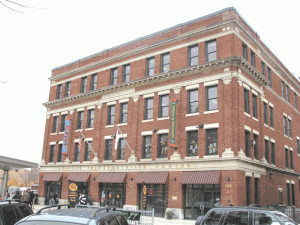
The Holyoke Transportation project was a complicated endeavor that involved a number of federal, state, and local agencies.
Eventually, state funds were secured to cover some of the additional costs, imaginative solutions were found for each of the construction challenges, and the parties involved essentially drew their own map for navigating uncharted waters in the form of an unprecedented public-private collaboration to create the center.
“We were essentially paving new ground; this was the first joint-development agreement undertaken in the country under the new FTA rules and regulations,” said Bob Schwarz, executive vice president of Communications for Peter Pan Bus Lines, and an individual Crowley credited with keeping the project on the rails during the innumerable times it appeared to heading off the tracks. “So we had nothing to go on; no one had ever done this before; we were laying the road.”
And as result of all this imagination and determination, the participatinbg parties were able to cut the ribbon last fall on a facility that Picknelly says makes a great deal of sense for the community.
“It’s a one-of-a-kind concept that has received national attention,” he said. “The components come together naturally — adult basic education, transportation to take people to those programs, and a childcare center for those with children.
“This is a one-stop shop to improve your life,” he continued, referring specifically to the many programs taking place in the Picknelly Adult and Family Education Center, named for his father. “It’s a place where people can make connections that can change their life.”
For this issue, BusinessWest chronicles the Holyoke Transportation project, a triumph over adversity in many respects, and now a working model that other communities may be looking to emulate.
Route of the Problems
As Crowley retold the story of how the center eventually came to fruition, he said that by the time Picknelly called him in 2006 and asked him to get involved, the project had been effectively dormant for some time.
There had been a memorandum of understanding inked between the Picknelly family and the PVTA in 2003 that outlined the partnership and the main battle plan for building the center, said Crowley, and many additional partners, from HCC to Head Start, to the city of Holyoke (which provided the real estate), had come on board, and thanks to the ardent support of U.S. Rep. John Olver, the various components of the project, and needed funding sources, were coming together nicely.
“They visualized a multi-modal transportation facility that would link inter-city and intra-city bus services involving carriers like the PVTA and Peter Pan, that would provide superior transportations services for the people ot Holyoke and the surrounding communities,”Crowley explained. “But what they also recognized was an absence of critical adult basic education services in the community, and looking at the demographics, this was a glaring problem — the fact that none of these services were being provided in a cohesive fashion.”
“What Peter (Picknelly), Bob (Schwarz), and Congressman Olver realized was that many of the people who needed adult basic education needed transportation to those services,” he continued. “Further, they understood that many of them also had kids, and in most cases, couldn’t leave those children to receive these education services — so Head Start became another critical element in the equation.”
This apparently solid game plan gained the support of the FTA and the state Executive Office of Transportation), which together had committed grants covering two-thirds of the project’s cost, and HCC had agreed to become anchor tenant and provide the adult basic education services.
But due to a series of circumstances — from the death of the elder Picknelly, who was providing the private equity for the project ($1 million) to turmoil at the PVTA and a subsequent change in leadership at the agency — the ambitious plans had been effectively back-burnered, although certainly not forgotten, said Crowley.
Indeed, by 2006, the PVTA, then being led by Mary MacInnes and determined to upgrade its facilities in Holyoke, one of the larger communities served by the agency, generated some dialogue about getting the initiative back on track.
But the landscape had changed considerably since 2003, said Crowley, noting that by then, the commercial real estate market was booming and construction costs were soaring, which meant that that the agreements between the parties would have to be renegotiated.
“When I looked at the development proposal that Peter had agreed to, and looked at the agreements that Head Start and Holyoke Community College had agreed to as tenants, and looked at the agreement that the PVTA had, it was evident to me that the project was financially unfeasible, and I indicated that (to the younger) Peter,” he explained. “But Peter, who recognized and appreciated that this was one of his father’s principle goals in life — to create this adult basic education center — didn’t want to give it up.”
Fast-forwarding a little, Crowley said the various agreements with the parties involved were revisited, and those leading the initiative went to Olver in the hopes of securing additional funding from the FTA to cover those escalating costs; a revised budget from the architect had moved the pricetag from the $7.5 million in 2003 to roughly $9.3 million (for both the building and an adjoining parking garage that was never built).
However, by this time (late 2006), the country was starting to slide into recession, and the federal government was putting the brakes on a number of projects, including many that were transportation related. So the parties involved with the Holyoke project agreed to essentially move forward knowing that there was a significant funding gap, said Crowley, adding that this was only one many serious problems lying in wait for this initiative.
“There were a number of points in the JDA where I think all the stakeholders, at one point or another, and for various reasons, almost threw in the towel,” he explained. “It was a daunting, daunting process. There was a ton of agencies involved — at the federal level, the state level, the city level … it was incredibly complex.”
Miles to Go …
Meanwhile, close inspections of the old central fire station revealed that those claims of ‘great bones,’ were untrue, or at least greatly exaggerated, and this meant that the recently revised budget was certainly imperiled.
For starters, the building, vacated at the start of the decade but still used for some training programs, had been exposed to the elements for seven years before construction was due to begin. This led the developers to do their own structural and environmental analyses — earlier reports indicated that the building was ‘clean’ — that found a number of large and costly problems.
Chief among them was the asbestos-based coating on the floors on the second, third, and fourth levels, a material applied 70 years earlier. “Everyone thought it was concrete, and we planned to just skim-coat over it,” Crowley explained. “And there was no way to get it up, other than with jackhammers and hand demolition.
“We had two options — encapsulating it, or removing it,” he continued. “But knowing that we were going to have Head Start and their children, and knowing the level of traffic this building was going to get from the general public, we made the decision to remediate it in its entirety, and if we couldn’t remediate it, we were going to scrap the plan.”
A subsequent inspection revealed that the deterioration of the I-beams that were carrying the first floor was so significant that they would have to be replaced, adding another $250,000 to the project’s cost.
“So now, we’re $770,000 behind the 8-ball, and this is before we’ve gone to bid to find out what it’s going to cost us to do the building,” he went on. “So that delayed us probably four months, because we, as the private-equity investors said, ‘we’re not going forward this — this is crazy; there are just too many unknowns.’”
But eventually, the many delays in negotiating agreements, securing the needed funds, inspecting the building, and resolving construction issues, turned out to be a blessing, because the rapidly deteriorating economy served to bring down the constructions costs associated with the project — and in a dramatic fashion.
“In most cases, time is you enemy with projects like this; in this instance, it was our friend,” said Schwarz, adding quickly that even with the attractive bids that would eventually be recived, the project would likely have been scuttled if state legislators had not secured a $750,000 grant from the EOT to handle the asbestos-removal efforts and floor replacement.
Construction wound up coming in two phases — demolition, handled by Kurtz Inc., in Southampton, and then reconstruction, undertaken by Western Builders in Granby, a subsidiary of Daniel O’Connell’s Sons in Holyoke — and there were myriad challenges in both cases.
Indeed, demolition of the floors proved to be a formidable obstacle, said Crowley, noting that due the composition of the concrete under the asbestos coating (sand mixed with large stones), the demolition efforts left a scarred, pitted surface that “looked like the surface of the moon.”
Rectifying the situation would require roughly three inches of new concrete, he continued, but the structural steel wouldn’t support that much weight. So a silicon-based substance, five times more expensive than concrete, had to be used.
Eventually, officials at HCC were able to secure a $550,000 federal grant that effectively enabled the developers to absorb ballooning expenses from the construction challenges and bring the project to completion, said Crowley, who stressed repeatedly, that there many figurative 10-foot walls with barbed wire that appeared to be insurmountable barriers, but solutions were ultimately found.
As they provided BusinessWest with a tour of the center, Crowley, Schwarz, and George Kohout, who directs the System for Adult Basic Education Support (SABES) for Holyoke Community College, at the Picknelly Center, all implied on numerous occasions that the facility was certainly worth all the aggravation, and that the unique model is working as those who blueprinted it intended.
Kohout said there are a number of programs conducted on the third and fourth floors of the facility, involving a number of agencies, from HCC to the New England Farmworkers Council; from the HALO (Holyoke Adult Learning Opportunities) Center to the Community Education Project; from the Holyoke Public Schools to CareerPoint.
Together, these partners offer services that include English as a Second language classes, GED testing, MCAS preparation, career counseling, “fast-track math,” English writing and composition, and computer training.
The central location, coupled with the accompanying transportation and childcare elements, not to mention the modern facilities, have all contributed to high enrollment and attendance levels that are certainly not coincidences, Kohout continued.
“Attendance has gone off the charts,” he explained. “And part of the reason for that is that many of these programs have been offered in places like the basements of churches or in other buildings with used furniture; when people come here and see the modern facilities, the state-of-art technology, bright colors, and the clean walls, it really ramps up what we call their ‘persistence’ in classes.”
In the big-picture perspective, that’s a word that can be applied to every aspect of this project.
Passing the Test
Looking back on all that transpired since that conversation with Peter Picknelly back in 2006, Crowley shook his head and said, “had I known then, what I know now …”
He didn’t finish the sentence, but the implication was certainly clear enough, and if it wasn’t, he then made it so by adding, “was this a labor of love? Maybe, but mostly, it was a just a labor.”
And mostly because all the parties involved didn’t know then what they know now, this unique project was able to come to fruition, bringing transportation, adult basic education, childcare, and even a coffee shop, together in an historical and improbable setting.
And so, the Holyoke project has become a study in perseverance — in more ways than one.
George O’Brien can be reached at [email protected]
Springfield’s Rebuilding Effort Comes at Intriguing Time for Urban Centers
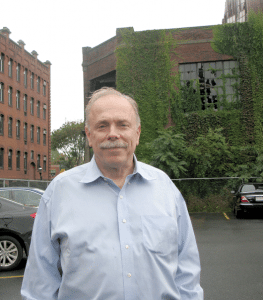
Dave Dixon says there is a surge in interest in urban living, which presents huge opportunities for cities like Springfield.
Dave Dixon was understandably wary about incorporating the phrase ‘silver lining’ into any statements he made concerning the June 1 tornado and its aftermath.
But he nonetheless put it to use as he talked about the efforts to rebuild Springfield and, more specifically, the work to revitalize the downtown and South End sections of the city. And that silver lining is all about timing and emerging trends in urban centers, he explained.
“If this tornado had struck 10 years earlier, let’s say, I think this would be a much grimmer task, because we’d be rebuilding in the face of continuing disinvestment in the city,” said Dixon.
He’s the principal in charge of planning and urban design at Goody Clancy, the Boston-based architecture, planning, and preservation firm now co-leading the efforts to blueprint a rebuilding plan for Springfield with New Orleans-based Concordia (see related story, page 62).
Elaborating, Dixon said that, over the past several years, there has been a discernable upswing in the popularity of urban living. Spawned by a number of factors, including a desire among aging Baby Boomers to live in places where they can walk rather than drive to most required destinations, the trend has helped transform a number of urban centers, many with the same social and economic challenges as Springfield’s central business district and South End.
“Ten years ago, the world didn’t look like this,” said Dixon, who has seen or helped orchestrate revivals in cities ranging from Baltimore to New Orleans to Wichita, Kan. “This disaster in Springfield, like the one in New Orleans, happened at a time when cities are changing and have opportunities that they haven’t had for 40 or 50 years.
“What has gone on, particularly over the past decade, has been a profound transition in demographics, in the way real-estate markets work, in the values that the folks who bring investment with them because they attract employers, have all undergone,” he continued, adding that there are more single individuals or couples (as opposed to families) than was the case a decade ago, and income levels for such people are higher. “There are simply more people that could decide they want to live in an urban environment. They may have wanted to in the past, but it didn’t work for them. And now they’re looking to make it work.”
Indeed, the real silver lining for Springfield, said Dixon, is an apparent, and growing, pent-up demand for downtown mailing addresses. To illustrate, he took out a piece of paper and sketched a simple chart showing the rising popularity of urban living.
The line moves upward at a steady clip, he explained while drawing, but the recession of the past several years has restricted the angle of ascent because, among other factors, homeowners looking to relocate to urban centers are still having trouble selling their homes, and market-rate housing builders are still being challenged in their efforts to finance such endeavors.
Like a dam holding back water, these factors are effectively bottling up demand, he continued, adding that, when conditions improve and that figurative dam breaks, cities properly positioned to capitalize on the trend could benefit significantly.
And in many ways, the tornado has helped put Springfield in such a position, he went on, acknowledging that the city still faces a number of challenges in this regard — including crime, the perception of same, and a concentration of subsidized-housing projects in both the downtown and South End — and that progress certainly won’t occur overnight.
But the city has many of the key ingredients to join the list of other success stories, he said, listing a decent “walkability index” — more on that later — a solid existing inventory of buildings that can be converted into market-rate housing, and, thanks to the tornado, some vacant acreage on which to build such housing, as well as businesses to sustain an urban population.
Dixon acknowledged that many are skeptical that such urban living could help transform Springfield’s downtown area, but he’s seen enough evidence of the trend in other parts of the country to believe it could certainly happen here.
Walking the Walk
As he talked with BusinessWest, Ron Mallis, a senior planner with Goody Clancy, was using his iPhone to see how well several downtown Springfield addresses fared on a Web site called walkscore.com. The site essentially assesses a location based on one’s ability to walk to amenities ranging from coffee shops to entertainment venues to banks, and gives it a score from 1 to 100, with the latter being the best.
The DevelopSpringfield office at 1182 Main St. earned an 89, while the Red Rose restaurant just a few blocks south notched an 82. Those statistics are not to be discounted, said Mallis, because many constituencies, from young artists to aging Boomers to business owners, are looking at such numbers with greater interest.
“People are more health-conscious than they were years ago,” he explained. “People have woken up to the fact that walking and health have a direct correlation, and that certainly plays a part in the decisions people are making about where they want to live.
Dixon agreed. “If you look at surveys about how much people want to drive, it used to be that, the younger you were, the more you liked getting in the car and driving; now it’s the reverse, and some of it is health-driven; it’s viewed as unhealthy to be in a car a lot.”
But there’s more to this trend than exercise, he continued, adding that many individuals within different age groups, when queried about what they want from a residential address, put that intangible ‘community’ high on their list. “And people think of urban areas as offering much more opportunity for community — to run into each other and meet each other.
“When you look at the top-10 criteria that people listed for where they wanted to live, from the ’60s up until probably 2003, or at least through the ’90s, it was golf courses, near golf courses, on a golf course, and as far away from work as possible,” he went on. “None of those are on the list in 2011. Surveys now show it’s proximity to Main Street, diversity, the ability to walk to work … and even telecommuters are much more interested in living in denser, walkable areas, perhaps because they spend the day by themselves.”
Dixon and Mallis have seen such trends emerge as they’ve helped Goody Clancy compile an extensive portfolio of work in older urban areas. The firm has taken part in a number of downtown projects, from guiding 12 million square feet of mixed-use development around the Massachusetts Institute of Technology to revitalization plans for communities as such as Baltimore, Akron, Ohio, Jamestown, N.Y., and, locally, Greenfield.
To illustrate his point on urban living and add a measure of credibility to the argument, Dixon pointed to Wichita, a city of about 900,000 and a downtown still fighting its way back from decades of disinvestment and an out-migration of people and businesses.
“Even the lawyers moved out of the downtown, which is unusual,” he said. “Compared to many parts of downtown Wichita, Springfield’s South End would look cool — it would look like an arts district. But downtown is beginning to take off; there are several hundred units of new, cool lofts — they’re rentals right now because the condo market isn’t there yet; one was rented out before it was finished, and another, more expensive building is almost rented out.
“Meanwhile, there’s another, more conventional project with larger, more expensive units that’s just sitting there because that’s not what the market’s going to come back to,” he went on. “The market’s about cool, urban, walkable living spaces. It’s more about living near a cool bakery than it is about giving a view.”
In Springfield, the firm has been assigned the task of coordinating efforts to develop strategic initiatives focused on the downtown and South End, one of three areas, or districts, of concentration involving neighborhoods impacted by the tornado. Since being hired in September, the firm’s representatives have undertaken a general inventory of this sector’s assets and liabilities, said Dixon, adding that there are more of the former than many people might think, and some could help the city take advantage of the pendulum moving back toward urban living.
And in many ways, the city is already making some strides, said Mallis, noting efforts to attract artists to the Morgan Square apartment complex (see BusinessWest, Aug. 29), and other initiatives to create more market-rate housing at several downtown-area properties.
As for the South End, Dixon said it has the potential to be “a hip place,” given its diversity, solid walk scores, proximity to many restaurants and cultural attractions, and decent inventory of properties that could, with some imagination, entrepreneurial flair, and requisite demand, be retrofitted into housing units.
As he walked with BusinessWest down Main Street, Dixon pointed out several such buildings near an already-thriving market-rate complex, the Willows, created from the former Milton Bradley manufacturing complex off Union Street. He gestured to everything from office and retail properties with large vacancy rates to abandoned or underutilized manufacturing and warehouse structures.
“You can just look at those properties and see that, if the market is there a half-block away,” he said, “it can be at those sites as well.”
There are also several currently vacant parcels, including the former Gemini site and some others created by the tornado, which provide opportunities for developers with vision.
Beyond vacant lots, though, the tornado has provided a spark for the city, said Dixon, when pressed about why market-rate housing and related developments haven’t happened sooner.
“As horrible and painful as the tornado has been for many people,” he said, “it has sort of galvanized the moment; it has the community focused, the city focused, everybody focused on how to rebuild better.”
Building Momentum
This combination of focus and determination has arrived at the intersection of rising interest in urban living and pent-up demand. It’s an intriguing situation that could make Springfield’s downtown the right place at the right time.
“Put all these things together, and Springfield, like many cities, has opportunities that it hasn’t had for a very long time,” said Dixon. “They don’t happen automatically, though. Cities have all these problems — fragmented land ownership, zoning, tax structures — which are not necessarily geared to the kind of development you want, and crime and the perception of crime.
“But there are lot of cities that have been very patient over the past 10 years, looking at what’s happening, removing the obstacles, investing in downtowns, and getting tremendous payoffs. Springfield has that opportunity; something like the tornado is a kind of wakeup call that it’s not just time to change, but to take stock. And when you take stock, you can take advantage of these opportunities.”
In other words, this could a silver lining that makes Springfield a shining example of how urban centers can be revitalized.
George O’Brien can be reached at [email protected]
Involvement, Strong Leadership Called Keys to Rebuilding Effort
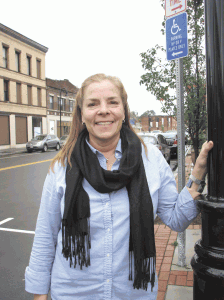
Bobbie Hill says plans and process are important, but involvement and leadership are the keys to revitalizing a city.
And she said there will be all three when it comes to the task of rebuilding Springfield in the wake of the June 1 tornado. However, none will be the real key to a successful effort.
Instead, the most vital component — and she says she’s learned this from considerable experience — is getting the residents of the community in question to take a real ownership stake in the recovery initiatives.
“It’s the relationship-building, the community-capacity-building, the taking-ownership piece,” said Hill, a consultant with the New Orleans-based planning and architecture firm Concordia, which is heading the team of companies coordinating Springfield’s rebuilding-plan process. “Those are the keys; it’s ownership, and holding yourself, your neighbors, elected officials, and developers accountable to doing it and doing it right.
“That engagement component, that people component, is as important if not more important than individual concepts,” she continued. “This can’t just be about development projects; that’s not what transforms a community.”
What does, she stressed again, is a willingness on the part of residents to get involved and stay involved, and not give in to the theory, or temptation, that government will take care of things. And it comes through leadership, she went on, noting that, in most every community where the 11-person firm has lent its disaster-response, planning, and design expertise, leaders from the community have emerged.
The process of getting the community involved in the rebuilding effort began earlier this month with neighborhood meetings in the three identified sectors involving areas of the city damaged by the tornado. Sector 1 is the metro center (downtown) and the South End, while Sector 2 is composed of Six Corners, Upper Hill, Old Hill, and Forest Park, and Sector 3 includes Sixteen Acres and East Forest Park.
Those neighborhood meetings were followed up with a city-wide gathering a few days later, and two more sessions of neighborhood meetings and another city-wide session are scheduled for November and December, said Hill, adding that the four firms collaborating on the endeavor will present an implementation and financing plan to a community congress on Jan. 5.
That’s the process, in simple terms, she said, adding that it’s too early to discuss specific potential redevelopment projects, although plenty of suggestions — from a supermarket to market-rate housing projects to reforestation proposals — have come forth at the neighborhood sessions.
In subsequent neighborhood meetings, the suggestions will be discussed at greater length, and eventually priorities will be established, and consultants will “put numbers” to potential recommendations in an effort to determine which ones make sense and which ones don’t.
More importantly, though, the initial sessions have yielded evidence of the requisite level of involvement, leadership, and community spirit that will be necessary for a successful recovery effort.
“I was really encouraged by what I saw and heard the other night,” she referring to the neighborhood meeting in Sector 2. “There was definitely a strong sense of community, people really caring for other and celebrating diversity — that really came across.”
There are four firms involved in the process of coordinating the neighborhood meetings and compiling the report to be completed Jan. 5. They are:
• Corcordia, which, among other projects in its portfolio, led coordination for the Unified New Orleans Plan after Hurricane Katrina that included selection and management of 12 national, regional, and local planning firms that created plans for 14 planning districts and an overall city-wide recovery plan;
• Goody Clancy, a Boston-based urban planning and design firm that has coordinated revitalization efforts in a number of major cities (see related story, page 60);
• Berkebile Nelson Immenschuh McDowell Inc. (BNIM), considered the most experienced firm in the country when it comes to helping tornado-impacted communities engage in a transformative recovery planning process; and
• The Project for Public Spaces (PPS), a nonprofit planning, design, and educational organization dedicated to helping people create and sustain public places that build stronger communities.
For more information on the process or to submit ideas online, visit www.rebuildspringfield.com. The schedule for future neighborhood and citywide meetings is as follows:
• Six Corners, Upper Hill, Old Hill, and Forest Park: Nov. 15, 6:30 to 9 p.m. at the J.C. Williams Center, Florence Street;
• Sixteen Acres, East Forest Park: Nov. 16, 6:30 to 9 p.m. at the Holy Cross gymnasium, Plumtree Road;
• Metro Center, South End: Nov. 17, 6:30 to 9 p.m. at the Gentile Apartments Community Room, Williams Street;
• Metro Center, South End: Dec. 6, 6:30 to 9 p.m. at the Gentile Apartments Community Room, Williams Street;
• Sixteen Acres, East Forest Park: Dec. 7, 6:30 to 9 p.m. at the Holy Cross gymnasium, Plumtree Road;
• Six Corners, Upper Hill, Old Hill, and Forest Park: Dec. 8, 6:30 to 9 p.m. at the J.C. Williams Center, Florence Street;
• City-wide: Dec. 10, 8:30 to 11:30 a.m. at the MassMutual Center; and
• Community Congress: Jan. 5, 6:30 to 9 p.m. at the MassMutual Center.
— George O’Brien
A listing of available commercial real estate
Click Here for PDF download
CommercialRealEstateBW1011b
A listing of available commercial properties
Click Here: CommercialRealEstate BW0911b
Historic Building Has a New Lease on Life

Opal Real Estate Group and city officials want to turn a neglected space into a vibrant, mixed-use facility.
Hanging on the wall behind Demetrios Panteleakis’ desk is a large painting of 31 Elm St. in Springfield, a building that most know simply as Court Square.
This historic block across from City Hall and Symphony Hall has remained vacant for decades. While the city has been diligent in keeping the property secure, time and nature have taken their toll on the elegant structure. Two other smaller buildings, Byer’s Block and the brownstone on the corner of Elm and Main known as the Chicopee Bank Building, are also part of a larger project that in recent months has city officials excited for the future of Springfield’s center.
Panteleakis is the managing partner of Opal Real Estate Group, the preferred developer for the site. The company, owned by Peter Picknelly, was one of the finalists back in 2008 to redevelop the property, but lost the bid to Connelly and Partners from Boston.
However, when that developer’s plans fell through, only a couple months old and a fast and furious victim of the economy, Opal was asked if it would like a second chance at bat.
The property is owned by the Springfield Redevelopment Authority (SRA), and in June of this year, Opal was named the preferred developer at Court Square. It was granted 120 days to come up with plans for funding and redevelopment, by all accounts a comprehensive and laborious process which examines every system of the structures, their history, and their potential future.
It’s an interesting moment of happenstance how Panteleakis came upon that painting, by the same artist responsible for the murals in the elevator lobbies of the very same building. Because, in many ways, the chance encounter with that work of art in an antique store is a metaphor for the larger forces now underway in the revitalization of the property. It’s a story of the right people in the right place at the right time.
Recently, BusinessWest had a chance to sit down with both Panteleakis and Brian Connors, the city’s point person for the property from the Office of Planning and Economic Development. The story they told is not one that has an easy answer. As Connors said, “if this project were a simple fix, it would have been done long ago.”
The difference this time is that, for Picknelly and his partners at Opal, the building is more than just another real-estate redevelopment opportunity. “Court Square was once the most vibrant part of the city,” Picknelly told BusinessWest. “Today, this is the best of New England — the grandeur of the historic buildings married to the modern structures nearby. Springfield is our home, and this building is at its core. In order for our city to be revitalized, this building can’t be abandoned.
“I believe, if done correctly, Court Square can be an important part of our city’s future,” he added. “Springfield simply cannot completely rebuild itself with this grand building left vacant.”
Center of Attention
Connors called the location “one of the most significant civic spaces in the entire Commonwealth,” and of the Court Square buildings themselves he simply said, “buildings that look like this just aren’t built anymore.”
The SRA also owns Union Station just a few blocks away, and he called both these sites key properties for Springfield’s future. Opal had been committed to the Court Square project for months before their preferred status, he said, and meets with city officials on a weekly basis to hammer out the ongoing issues that arise with a project of this scope.
“You don’t just hand over the keys and start construction,” he said. “It’s really a lot of due-diligence work. Opal, meanwhile, is getting all their applications in, their historic tax credits, their financing. We’re very excited to have a private partner advancing this as quickly as they can, with the best of all their expertise. They know Springfield, and they’ve worked on historic redevelopment.”
Patting his hand on a ream of Opal’s paperwork, only a fraction of the documents and reports that will chart the project’s course, Connors added, “this is already making far more progress than ever before.”
But he acknowledged the hard work ahead for both his office and the people at Opal. Between environmental and structural assessments, neither of which is tossing any unforeseen obstacles, and the funding sources, all parties involved will be kept busy before a hammer or shovel hits the site.
Funding is a crucial piece of the puzzle. “A project like this requires every sort of alphabet soup of incentives that are possible — federal, historic, and state tax credits,” he said. “And these are all competitive funds, so those applications are going in now. In a financial environment like there is today, funding is difficult. Banks aren’t loose with their money. City governments don’t have a lot of money.”
Family Ties
Although Connors said that Opal’s preferred 120 days ends in November, if the SRA board is satisfied by the developer’s efforts, the agreement will be extended.
“I can say from our experience, on a staff level we’re working with Opal on a weekly basis, and we’re very satisfied with the progress that’s been made,” he added.
Right now, Panteleakis said, the biggest obstacle his office faces is time.
“We’re in a race to take all the knowledge we’ve accumulated and verify it,” he said. “Because there’s been an RFP for the last ten years, there’s been a lot of study on the building. But for our grant purposes we need to go back and reassess all of it — mechanical, electrical, environmental.”
Opal is no stranger to historic redevelopment; currently it is at work on an historic property in the center of Westfield destined to be student housing for the state university there. At Court Square, Panteleakis said that a careful look at the past success of the buildings can indeed map out a bit of their future.
“You have to look at it less than conceptually,” he said, “and realize that, 25 to 30 years ago, this building had a viable commercial population. And that has a lot to do with location, location, location.”
The plans as they exist now aren’t to reinvent the uses of the building. Although the top floor is presently envisioned as market-rate housing, with apartments of up to four bedrooms, the first floor will remain retail- or service-oriented, with amenities that would cater to a residential or professional population that lives and works in the area. Middle floors are to be mixed commercial use, and there has been great interest in that space, both Panteleakis and Connors said.
Panteleakis, in fact, said the response has been “tremendous.”
“The development process that takes place in a building this size clearly has a point before hammers start to swing where you get a minimum level of commitment in order to have an economically viable project,” he explained. “We are in those conversations now, and we’re trying to firm up some of those commitments by January.”
Responding to criticism of what some may perceive as a surfeit of vacant office space in the city, Panteleakis waved off the possibility to naysay. “There’s a larger philosophical issue that needs to be examined. Anyone can say, ‘there’s too much office and retail space already,’ but it’s the quality of the product that brings people to the downtown. The bottom line is that, when you improve the quality of the product and create competition in that product, it forces everyone to get better.”
Here, he credited the redevelopments that the Dennis Group has made downtown, and how they raised the bar for those sections of Springfield where their historic buildings have been renovated.
Like Picknelly, Panteleakis said that Court Square resonates in his own remembrance of Springfield’s history. And that connection to the past is an important aspect to rebuilding for the future.
“If you have any commitment at all to the city of Springfield, or if you’ve been in the real-estate business and owned property in Springfield,” he said, “you’d know how important this location is. To come to what is probably the most architecturally significant building in the heart of the city, and to see it in disrepair, it makes an immediate statement to visitors to the city, and that has to be reversed.”
This is the type of project that comes along once in one’s career, he said.
“This is Springfield’s legacy,” he went on. “If buildings like this aren’t preserved, future generations are only going to see them in photographs.”
Pointing to the painting over his head, he added, “this is one that will be saved.”




